By Sam Robinson |
at June 27, 2022 7:05 pm
After making five straight playoff berths from 2011-15, a stretch that included four consecutive AFC byes and two Super Bowl appearances, the Broncos have drifted well off that pace. Years in quarterback wilderness followed Peyton Manning‘s 2016 retirement. But the 2022 offseason represents a significant step toward the franchise moving back onto the contender track.
This season should feature the Broncos as a more formidable operation, and it doubles as a chance to see how promising Denver’s oft-discussed skill-position corps really is. A loaded AFC West hovers over Denver’s offseason rise, but the franchise has clear reasons for optimism. A team frequently labeled as a QB away from mattering in the grand scheme now has its coveted passer.
Trades:
Linked to Aaron Rodgers for nearly a year, the Broncos began this offseason’s trade avalanche by completing a deal for a quarterback five years younger. Denver was never linked as a true Deshaun Watson suitor, and its 2021 Matthew Stafford offer was far less enticing than the one the Rams made. But the Broncos had also not been closely connected to Wilson, who left the team off his list of acceptable trade destinations during the 2021 offseason but included them (albeit quietly) later in the year. He will now have a chance to craft an interesting second act.
The Seahawks bailed midway through their franchise quarterback’s third contract, not eager to pay the new going rate for the 33-year-old star whose current $35MM-per-year deal topped the market at the time (April 2019). This opened the door for the Broncos to fill one of the NFL’s longest-standing needs. Other teams pursued the decorated QB — from the Panthers to the Eagles to the Commanders, with Washington offering three first-rounders — but Wilson only ended up waiving his no-trade clause for the Broncos.
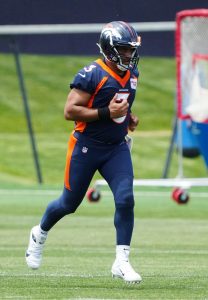 If 2020’s Kendall Hinton-quarterbacked contest is counted, the Broncos match Washington with an NFL-most 11 starting QBs since 2016. An inability to generate above-average QB play through trades (Joe Flacco, Teddy Bridgewater), free agency (Case Keenum) or the draft (Lock, Paxton Lynch) dragged Denver from an AFC power to a team with a lower-middle-class ceiling. This descent prompted second-year GM George Paton to fork over one of the biggest trade hauls in NFL history — though a package not quite as valuable as some expected — to make a clear upgrade.
If 2020’s Kendall Hinton-quarterbacked contest is counted, the Broncos match Washington with an NFL-most 11 starting QBs since 2016. An inability to generate above-average QB play through trades (Joe Flacco, Teddy Bridgewater), free agency (Case Keenum) or the draft (Lock, Paxton Lynch) dragged Denver from an AFC power to a team with a lower-middle-class ceiling. This descent prompted second-year GM George Paton to fork over one of the biggest trade hauls in NFL history — though a package not quite as valuable as some expected — to make a clear upgrade.
The quarterback that helped Seattle decimate a depleted Denver team in Super Bowl XLVIII, Wilson grew into a top-flight passer in the years that followed. While the Seahawks transitioned from a team built around the Legion of Boom to a Wilson-centric operation, Pete Carroll insisted on keeping a run-oriented offense in place. The Seahawks also frequently skimped on offensive line investments. The Broncos do not boast a high-end O-line, either, but this could be the deepest collection of skill-position talent Wilson has enjoyed. Injuries and inconsistent QB play have limited Denver’s armada of highly drafted receivers (feat. steady ex-UDFA Tim Patrick) from making much of an impact. The Courtland Sutton–Jerry Jeudy–K.J. Hamler trio appears set for its most relevant NFL stretch.
Coming back after just three games from his right middle finger tendon rupture, Wilson did not look himself for much of the season’s second half. He finished with a career-low 54.7 QBR, but the ex-Seattle cornerstone represented the main reason the post-Super Bowl XLIX Seahawk editions remained contenders. Wilson put up his first two 4,000-yard seasons in 2019 and ’20 and eclipsed 30 touchdown passes from 2017-20, topping out with 40 in 2020. The Broncos have surpassed 20 TD passes as a team just once in the past seven seasons. They have not ranked in the top half of the league in scoring or total offense in that span. These stats may well come up during Wilson extension talks.
Set to tailor their offense to the relocated passer’s strengths, the Broncos will bet on Wilson bouncing back in a Nathaniel Hackett-led attack likely to feature more passing opportunities compared to the future Hall of Famer’s previous setup. From 2012-21, the Seahawks ranked 32nd in pass attempts — by a wide margin — with 30.4 per game. This season will double as a referendum on the Seahawks’ Wilson-era strategy, at least in the years since Marshawn Lynch‘s prime ended, and a chance for the 11th-year QB to show he is capable of thriving in a pass-first offense for an extended stretch.
Notable signings:
- Randy Gregory, LB: Five years, $70MM. $28MM guaranteed
- D.J. Jones, DL: Three years, $30MM. $20MM guaranteed
- Josey Jewell, LB: Two years, $11MM. $6MM guaranteed.
- K’Waun Williams, CB. Two years, $5.2MM. $2.5MM guaranteed.
- Melvin Gordon, RB. One year, $2.5MM. $2.25MM guaranteed.
- Billy Turner, T: One year, $2.5MM. $2.25MM guaranteed.
- Kareem Jackson, S. One year, $2MM. $2MM guaranteed.
- Tom Compton, OL. One year, $2.25MM. $1.5MM guaranteed.
- DeShawn Williams, DL. One year, $1.17MM. $200K guaranteed.
- Alex Singleton, LB. One year, $1.12MM. $150K guaranteed.
- Eric Tomlinson, TE. One year, $1.44MM. $100K guaranteed.
- Josh Johnson, QB. One year. $1.22MM. $100K guaranteed.
Last year’s Von Miller trade afforded the Broncos flexibility to reach deep into their draft assets to acquire Wilson, but it left the team with its most glaring edge need since Miller’s 2011 arrival. While rumors emerged about the Broncos pulling a Yankees-like Aroldis Chapman maneuver — trading a player at the deadline and then re-signing him the following offseason — they went with Gregory at a lower rate. Gregory reneged on a Cowboys contract at the 11th hour, spurning his seven-year (off-and-on) employer due to language that made it easier to void guarantees.
 Signing the former suspension mainstay is a gamble for the Broncos; the 2015 second-rounder has been banned four times for substance-abuse policy violations. Between the 2016, ’17 and ’19 seasons, Gregory combined for two games. This could give him a “young 29”-type presence, due to limited wear and tear, but Gregory also missed time with a calf injury and has been limited this offseason due to shoulder surgery. Still, Gregory’s early-season surge in 2021 (five sacks, 11 QB hits and two forced fumbles in a four-game span), before his calf issue paused that stretch, created a live market. How Gregory lives up to his first notable NFL contract will determine the Broncos’ post-Miller pass-rushing outlook.
Signing the former suspension mainstay is a gamble for the Broncos; the 2015 second-rounder has been banned four times for substance-abuse policy violations. Between the 2016, ’17 and ’19 seasons, Gregory combined for two games. This could give him a “young 29”-type presence, due to limited wear and tear, but Gregory also missed time with a calf injury and has been limited this offseason due to shoulder surgery. Still, Gregory’s early-season surge in 2021 (five sacks, 11 QB hits and two forced fumbles in a four-game span), before his calf issue paused that stretch, created a live market. How Gregory lives up to his first notable NFL contract will determine the Broncos’ post-Miller pass-rushing outlook.
The Broncos now feature an interesting edge situation, one that houses former top-five pick Bradley Chubb, frequent fill-in starter Malik Reed and second-round pick Nik Bonitto. But if Gregory cannot recapture the near-All-Pro-caliber form he showed early last season, Denver’s plan could crumble. If Gregory can craft a post-Dallas prime arc, the Broncos having him tied to a $14MM-per-year pact — at a time when 21 edge rushers out-earn him — would present a roster-building advantage.
Read more
Jones stands to replace Harris as a 3-4 defensive end who will spend most of his time inside. The former 49ers fifth-rounder broke through as a run defender last season, representing a difficult blocking assignment. His presence, along with contract-year five-technique Dre’Mont Jones, should help Gregory, Chubb and Co. D.J. Jones, 27, is also light on stats for an eight-figure-per-year player. Denver’s front office is betting on higher peaks being ahead for both he and Gregory. The 2021 Broncos finished 20th in defensive DVOA, a figure that views their third-place total-defense ranking with skepticism, and 28th in true pressure rate last season — one with minimal Miller and Chubb contributions. Paying up for D-line help made sense through these lenses.
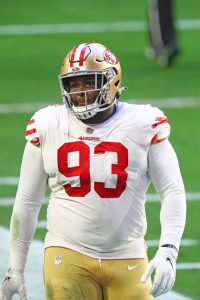 Although Bryce Callahan was effective when on the field for the Broncos, the $7MM-per-year slot defender became one of the NFL’s most injury-prone players while in Denver. The 49ers’ slot cover man for the past five years, Williams poses a cheaper replacement. Williams, 31 in July, has been one of the better slot players in recent years. He has combined to allow two touchdowns as the closest defender in coverage since 2019.
Although Bryce Callahan was effective when on the field for the Broncos, the $7MM-per-year slot defender became one of the NFL’s most injury-prone players while in Denver. The 49ers’ slot cover man for the past five years, Williams poses a cheaper replacement. Williams, 31 in July, has been one of the better slot players in recent years. He has combined to allow two touchdowns as the closest defender in coverage since 2019.
Gordon, 29, re-signing will irk fantasy GMs come August, and ill-timed fumbles have dinged his approval rating with his real team’s fanbase. But the former first-round pick has averaged north of 4.5 yards per carry in each of his two Broncos seasons (10 touchdowns apiece). Gordon’s return also stands to prevent physical runner Javonte Williams from overuse, which teams eyeing post-rookie-deal partnerships with running backs must consider early. The Broncos initially signed Gordon to a two-year, $16MM deal. Having the ex-Charger back at $2.5MM should prove a nice value play.
Vic Fangio-era starters Jewell and Jackson are stopgaps at this point. The Broncos have not made a true inside linebacker investment since their 2016 Brandon Marshall extension. The 2022 team should be much deeper on the edge, especially after a curious move of shifting 2021 inside starter Baron Browning to OLB. Its Jewell-led ILB corps — one that also houses low-salaried supporting casters in Singleton and Jonas Griffith — could become an issue. Jackson will be one of the league’s oldest non-QB starters, at 34, but he has played effectively since making the full-time corner-to-safety switch upon moving to Denver three years ago. He adds a cost-effective starter alongside Justin Simmons, the NFL’s fourth-highest-paid safety.
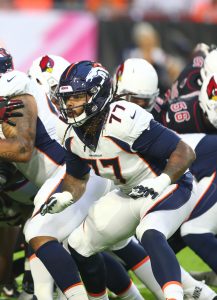 The winner of this summer’s Compton-Turner competition will be the Broncos’ 10th Week 1 right tackle in 10 seasons. Since Denver relocated Orlando Franklin to guard in 2014, stability has proven elusive on the right edge of its O-line. This streak could run to 11 in 2023, with Turner and Compton on one-year deals. PFF graded Compton as a top-20 tackle last season, when he filled in for an injured Mike McGlinchey in San Francisco, while Turner scored a semi-lucrative Packers contract on the back of a solid contract-year run with the 2018 Broncos. Although Turner missed minicamp due to injury, his experience in Hackett’s offense likely makes him the favorite to start. The loser here would represent quality swing depth. Compton and Turner have guard experience, but the Broncos have a few inside options they are considering to start the Hackett era.
The winner of this summer’s Compton-Turner competition will be the Broncos’ 10th Week 1 right tackle in 10 seasons. Since Denver relocated Orlando Franklin to guard in 2014, stability has proven elusive on the right edge of its O-line. This streak could run to 11 in 2023, with Turner and Compton on one-year deals. PFF graded Compton as a top-20 tackle last season, when he filled in for an injured Mike McGlinchey in San Francisco, while Turner scored a semi-lucrative Packers contract on the back of a solid contract-year run with the 2018 Broncos. Although Turner missed minicamp due to injury, his experience in Hackett’s offense likely makes him the favorite to start. The loser here would represent quality swing depth. Compton and Turner have guard experience, but the Broncos have a few inside options they are considering to start the Hackett era.
Wilson has missed just three games in 10 seasons, lessening the need for a quality backup. Still, the Broncos going with Johnson is interesting given his historically nomadic career and his roles in recent years. The journeyman (putting it mildly; he has been with 17 teams across four leagues) is being given a chance as a primary backup, after spending much of his career bouncing on and off rosters. Johnson, 36, did not see regular-season action from 2019-20 and has played in four leagues — the NFL, United Football League, Alliance of American Football and XFL 2.0 — since being a 2008 fifth-round pick. He saw action for the Jets and Ravens last year, stepping in to complete 67% of his passes at 7.6 yards per attempt. Brett Rypien, a 2019 UDFA who was part of the Broncos’ aforementioned 11 QBs to start a game since 2016, remains on the roster as well.
Notable losses:
- Teddy Bridgewater, QB
- Bryce Callahan, CB
- Noah Fant, TE
- Kyle Fuller, CB
- Nate Hairston, CB
- Shelby Harris, DL
- Alexander Johnson, LB
- Drew Lock, QB
- Bobby Massie, T
- Stephen Weatherly, DE
- Kenny Young, LB
 Bridgewater’s second concussion of 2021, coming against the Bengals in Week 14, essentially closed the book on the Broncos’ playoff hopes. While the limited passer’s hot start proved to be somewhat of a mirage, Bridgewater played hurt and had moments throughout the season.
Bridgewater’s second concussion of 2021, coming against the Bengals in Week 14, essentially closed the book on the Broncos’ playoff hopes. While the limited passer’s hot start proved to be somewhat of a mirage, Bridgewater played hurt and had moments throughout the season.
Fangio’s staff only inserted Lock as a last resort last season. The 2020 season’s INT leader, despite missing three games, Lock will have a legitimate chance to succeed Wilson in Seattle. Last year marked Lock’s smoothest offseason, after a 2020 OC change and the pandemic keeping players offsite until training camp. The former second-rounder’s failure to beat out Bridgewater helped seal his fate in Denver.
Pro Football Focus consistently rated Johnson as a top-performing off-ball linebacker, slotting him as a top-five player at his position in 2019 and 2021. Though, Johnson went down midway through last season with a torn pec. Johnson helped stabilize the Broncos’ defense upon moving into the lineup early in the 2019 season but profiled as more run-downs thumper than coverage ‘backer. That old-school skillset is not valued much in today’s game. It is still surprising Johnson has not found a home, but the first-time UFA is already 30. Time is running out for the late-arriving NFLer to cash in beyond his 2021 RFA tender. If the thin Broncos ILB corps underwhelms during camp, might a short-term Johnson reunion be considered?
One of the team’s most popular players, Harris found a home as part of Vance Joseph‘s defenses in the late 2010s and secured a three-year, $27MM extension during Paton’s first months in the GM chair. The Broncos will miss the veteran’s versatility and threat of pass deflections (25 since 2017), but D.J. Jones may be an upgrade. Rodgers trade rumors frequently included the Broncos giving up one of their top three wideouts. The Wilson deal only requiring a Fant inclusion could be a seminal moment for the Broncos, who have Sutton and Patrick tied to now-team-friendly extensions.
Draft picks:
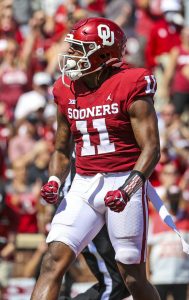 One of this draft’s quickest pass rushers, Bonitto gives the Broncos a deep edge-rushing contingent. He totaled 16 sacks over the past two seasons and profiles as a potential long-term Gregory complementary rusher.
One of this draft’s quickest pass rushers, Bonitto gives the Broncos a deep edge-rushing contingent. He totaled 16 sacks over the past two seasons and profiles as a potential long-term Gregory complementary rusher.
Both Chubb and Reed are due for free agency in 2023. With each being a John Elway-era investment, how the Broncos arrange a roster with these two and Bonitto will be interesting come August. Reed’s low-end RFA tender ($2.43MM) could make him a trade candidate, especially with Paton-era pickups Browning and Jonathon Cooper looming as edge backups. But Chubb and Gregory’s injury histories should induce the Broncos to place a premium on OLB depth when they set their 53-man roster.
Albert Okwuegbunam is going into a contract year, giving Dulcich an onramp to be Wilson’s long-term tight end. With tight end learning curves proving steep in most cases, Dulcich having a season to develop alongside Okwuegbunam may be critical. The younger tight end does not have the ex-Mizzou pass catcher’s 4.4-second 40-yard dash speed, but Dulcich arriving as a Paton-Hackett investment points to him being given every opportunity to show he can be a long-term piece. He of back-to-back seasons averaging north of 17 yards per catch at UCLA, the first a 517-yard slate despite a pandemic-shortened 2020 season, Dulcich should be part of Denver’s 2022 equation this season before taking on a bigger role in 2023.
Extensions and restructures:
Other:
Winning out over fellow finalists Dan Quinn and Kevin O’Connell, Hackett has completed a successful rebound after being fired from his post as Jaguars OC in 2018. Hackett calling plays for the 2017 Jaguars, helping a Blake Bortles-quarterbacked team to the Super Bowl LII precipice, aged remarkably well given what has happened in Jacksonville since. The Jags ranked fifth in total offense and sixth in scoring in 2017, despite the team losing No. 1 wideout Allen Robinson in Week 1.
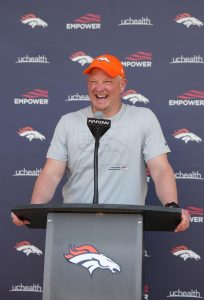 After that operation fell apart the following season, Hackett resurfaced as a key voice for a Packers team that rebounded under Matt LaFleur. Rodgers has praised Hackett frequently, and it is undeniable the second-generation NFL coach had a hand in the future Hall of Famer’s back-to-back MVPs. This will be Hackett’s first time as a primary play-caller since Jacksonville, however, adding to the intrigue surrounding the now-Wilson-led Denver offense.
After that operation fell apart the following season, Hackett resurfaced as a key voice for a Packers team that rebounded under Matt LaFleur. Rodgers has praised Hackett frequently, and it is undeniable the second-generation NFL coach had a hand in the future Hall of Famer’s back-to-back MVPs. This will be Hackett’s first time as a primary play-caller since Jacksonville, however, adding to the intrigue surrounding the now-Wilson-led Denver offense.
Hackett, 42, hired coordinators light on experience — particularly on the offensive side. After the Packers blocked the new Broncos HC from poaching offensive line coach (and now-Green Bay OC) Adam Stenavich, Green Bay also stopped wide receivers coach Jason Vrable from interviewing for the Denver OC job. Outten, Green Bay’s previous tight ends coach, then landed the Denver OC gig. Hackett prioritizing familiarity, as evidenced by college teammate and longtime friend Evero being hired as DC, might be a risk for the Broncos. Outten, 38, only has three years of NFL position-coaching experience. Prior to 2019, he was an entry-level assistant in Atlanta.
Hackett calling plays will give Outten some cover. Evero, 41, will succeed Fangio, one of this era’s premier defensive minds, in running the other side of the ball. The Rams promoted Evero, their four-year safeties coach, to secondary coach in 2021. A one-year Evero coworker in Los Angeles and a one-year Denver assistant, Brandon Staley did land his Rams DC gig with less NFL experience. And Evero’s star could be on a similar rise. Denver’s collective coordinator inexperience is probably not receiving enough attention this offseason, though the team has produced a few bigger storylines.
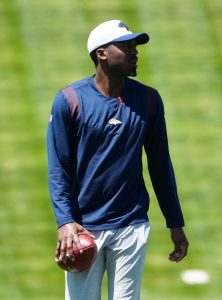 One of those came this month, when Walton’s group shattered David Tepper‘s NFL-record bid for a franchise. Rob Walton, a 77-year-old son of Walmart founder Sam Walton, will become the NFL’s richest owner by a wide margin. With a net worth of approximately $70 billion, Rob Walton more than quadruples the value of the second-wealthiest NFL owner (Tepper). This may prove relevant soon.
One of those came this month, when Walton’s group shattered David Tepper‘s NFL-record bid for a franchise. Rob Walton, a 77-year-old son of Walmart founder Sam Walton, will become the NFL’s richest owner by a wide margin. With a net worth of approximately $70 billion, Rob Walton more than quadruples the value of the second-wealthiest NFL owner (Tepper). This may prove relevant soon.
With the Browns’ Watson contract potentially changing the way teams do business with quarterbacks, Wilson — whose 2015 and 2019 Seahawks extension negotiations proved eventful — could make a logical push to top Watson’s $46MM AAV and $230MM fully guaranteed sum. The Broncos might be prepared to table Wilson talks until 2023, his contract year, but such a wait could lead to negotiations commencing after another shift in the QB market. Kyler Murray and Lamar Jackson may be extended between now and 2023. Waiting has benefited QBs recently — evidenced by Dak Prescott‘s strategy. Considering the Broncos’ QB struggles in recent years and factoring in the new-look market at the position, Wilson agent Mark Rodgers — who has one NFL client — figures to reference Watson’s deal to an ownership group that would have no issue unearthing funds for such a guarantee.
Top 10 cap charges for 2022:
- Russell Wilson, QB: $24MM
- Garett Bolles, T: $21MM
- Justin Simmons, S: $18.85MM
- Ronald Darby, CB: $12.82MM
- Bradley Chubb, LB: $12.71MM
- Graham Glasgow, OL: $6.1MM
- Randy Gregory, LB: $5.6MM
- Courtland Sutton, WR: $5.33MM
- Pat Surtain II, CB: $4.76MM
- Tim Patrick, WR: $4.61MM
Early returns on Paton’s 2021 draft led to some optimism ahead of the GM’s second year, and the Wilson acquisition raises the veteran executive’s profile while brightening the spotlight on the Broncos’ season. The franchise toiled in anonymity for a while, but its 2022 schedule is full of primetime windows. Elway’s inability to land a Manning successor resulted in his Super Bowl 50 nucleus’ Denver tenures ending meekly. Will the roster the Broncos have steadily rebuilt end up giving Wilson a better chance to make a true Super Bowl push?
By Ben Levine |
at September 7, 2017 11:07 am
The Patriots completed the biggest comeback in Super Bowl history, and they followed that up with an equally aggressive offseason. New England made a number of notable trades and free agent signings beginning in March to load up for Tom Brady‘s twilight seasons.
While 2017 contributors like Martellus Bennett and Logan Ryan took paydays elsewhere, the Patriots quickly replaced the departures with names like Dwayne Allen and Stephon Gilmore. New England also brought in dynamic, young wideout Brandin Cooks, a pair of intriguing running backs, and former Jets linebacker David Harris.
However, despite all of the names New England brought in this offseason, the biggest moves might have been the trades they didn’t make…
Notable signings:
- Stephon Gilmore, CB: Five years, $65MM. $31M guaranteed.
- Duron Harmon, S: Four years, $17MM. $6.5MM guaranteed.
- Lawrence Guy, DL: Four years, $13.4MM. $4.9MM guaranteed. $5.6MM available via incentives.
- Mike Gillislee, RB: Two years, $6.4MM. $3.5MM guaranteed. Bills declined to match Patriots RFA offer sheet.
- Alan Branch, DT: Two years, $8.45MM. $3MM guaranteed.
- David Harris, LB: Two years, $5MM. $1.25MM guaranteed. $1.75MM available via incentives.
- Rex Burkhead, RB: One year, $3.15MM. $1.1MM guaranteed.
- James Develin, FB: Two years, $2.45MM. $500K guaranteed. $400K available via incentives.
- Malcolm Butler, CB: One year, $3.91MM. Signed first-round RFA tender.
- Cameron Fleming, T: One year, $1.797MM. Signed original round RFA tender.
The Patriots first signing of the offseason was also the most lucrative. The organization convinced cornerback Stephon Gilmore to switch AFC East teams, handing him the most guaranteed money for a defensive player in franchise history. While trade rumors surrounded fellow cornerback Malcolm Butler for much of the offseason (before he ultimately signed his first-round restricted free agent tender…more on that later), the former Super Bowl hero is still in New England, and Gilmore figures to play alongside the former undrafted free agent.
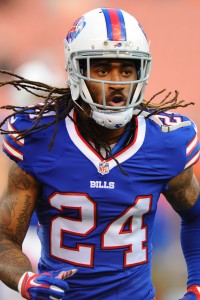 Gilmore, a 2012 first-round pick, set a career-high with five interceptions last season, and he also compiled 48 tackles and 12 passes defended. ProFootballFocus wasn’t particularly fond of his performance in Buffalo, ranking him 61st among 110 eligible cornerbacks. Butler, meanwhile, ranked seventh, and despite Gilmore’s shortcomings, the two cornerbacks should still form a formidable duo.
Gilmore, a 2012 first-round pick, set a career-high with five interceptions last season, and he also compiled 48 tackles and 12 passes defended. ProFootballFocus wasn’t particularly fond of his performance in Buffalo, ranking him 61st among 110 eligible cornerbacks. Butler, meanwhile, ranked seventh, and despite Gilmore’s shortcomings, the two cornerbacks should still form a formidable duo.
To solidify the secondary, the Patriots also re-signed safety Duron Harmon, who had spent the first four seasons of his career in New England. The 26-year-old was given a bit more responsibility in 2016, and he responded with 29 tackles, one interception, and forced one fumble in 16 games (four starts). Harmon should once again serve as a rotational piece behind starters Devin McCourty and Patrick Chung.
The Patriots weren’t finished shaping their defense via free agency. Perhaps one of the most notable moves was the signing of linebacker David Harris, who joined New England following 10 years with the Jets. The 33-year-old certainly showed signs of decline in 2016, finishing with his lowest tackle total (86) since 2011 and the lowest sack total (0.5) of his career. Still, the veteran fills a bit of hole for the Patriots (especially following injuries to Shea McClellin and Derek Rivers), and he figures to start at linebacker for his new team.
To round out the defense, the team re-signed defensive tackle Alan Branch and signed veteran lineman Lawrence Guy. Branch has started 31 games for the Patriots over the past two seasons, and his favorable Pro Football Focus grading (26th among 125 eligible interior defenders) justifies why he’ll be starting alongside Malcom Brown once again. Guy has primarily played a reserve role throughout his career, although he did start a career-high 10 games last year for the Ravens. Considering the youth of his fellow defensive ends, Guy might get the starting defensive end gig with Trey Flowers.
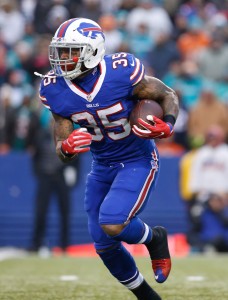 On the offensive side of the ball, the Patriots made several signings as they looked to replace the departed LeGarrette Blount. New England’s running game is usually unpredictable, but Mike Gillislee figures to play a prominent role in 2017. The former fifth-round pick made a name for himself last year with the Bills, compiling career-highs in attempts (101), yards (577), and rushing touchdowns (eight). Of course, the Patriots coaches were probably most enticed by his one career fumble, and his career 6.7-yards-per-carry mark is a big reason why he could be the main replacement for Blount. The Patriots also signed former Bengals running back Rex Burkhead, who also had a bit of a breakout year in 2016. Injuries limited the 27-year-old during the preseason, although there’s always a chance that Burkhead can ultimately lead the team in carries. The Patriots have always thrived when using an unpredictable running game, and we’ll presumably see the team utilize the best backs for specific matchups.
On the offensive side of the ball, the Patriots made several signings as they looked to replace the departed LeGarrette Blount. New England’s running game is usually unpredictable, but Mike Gillislee figures to play a prominent role in 2017. The former fifth-round pick made a name for himself last year with the Bills, compiling career-highs in attempts (101), yards (577), and rushing touchdowns (eight). Of course, the Patriots coaches were probably most enticed by his one career fumble, and his career 6.7-yards-per-carry mark is a big reason why he could be the main replacement for Blount. The Patriots also signed former Bengals running back Rex Burkhead, who also had a bit of a breakout year in 2016. Injuries limited the 27-year-old during the preseason, although there’s always a chance that Burkhead can ultimately lead the team in carries. The Patriots have always thrived when using an unpredictable running game, and we’ll presumably see the team utilize the best backs for specific matchups.
Fullback James Develin will be back in New England for another season, as the team re-signed him to a two-year deal. The 29-year-old doesn’t play much of a role in the Patriots rushing game, but he’s proved to be a very capable blocker, as Pro Football Focus rated him third among 15 eligible fullbacks. The Patriots also re-signed tackle Cameron Fleming, who had spent the first three seasons of his career with the organization. The 25-year-old has primarily seen time as a reserve during his New England tenure, starting 14 career games.
Read more
Notable losses:
- Martellus Bennett, TE
- LeGarrette Blount, RB
- Kony Ealy, DE: Waived
- Michael Floyd, WR
- Tre’ Jackson, OL: Waived
- Chris Long, DE
- Barkevious Mingo, LB
- Rob Ninkovich, DE: Retired
- Logan Ryan, CB
- Jabaal Sheard, DE
- Sebastian Vollmer, T: Retired
The Patriots saw the departure of several players who played significant roles in the team’s recent postseason run. LeGarrette Blount was perhaps the most notable of those names, as he had collected 677 carries with New England since 2013, including a career-high 299 attempts in 2016. The veteran had his best NFL season in 2016, finishing with 1,161 rushing yards and a league-leading 18 rushing touchdowns. However, his 3.9-yards-per-carry was a bit disconcerting, and the Patriots ultimately decided to pursue fresher legs in Gillislee and Burkhead.
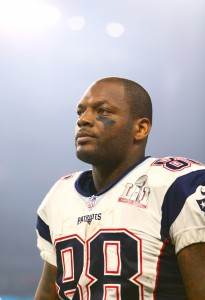 Tight end Martellus Bennett had a bounce-back campaign during his lone season in New England, finishing with 55 receptions for 701 yards and seven touchdowns. While the veteran proved to be an excellent compliment (as well as injury insurance) to tight end Rob Gronkowski, the Patriots seemingly weren’t willing to pay their technical “second tight end” the money he was seeking. Bennett ultimately parlayed his Super Bowl success into a lucrative contract from the Packers. Meanwhile, fellow offensive weapon Michael Floyd proved to be a dud during his brief cameo with the Patriots. The embattled wideout ultimately hauled in five receptions during his three-game stint (including playoffs) with the organization. He ultimately signed a contract with the Vikings this offseason.
Tight end Martellus Bennett had a bounce-back campaign during his lone season in New England, finishing with 55 receptions for 701 yards and seven touchdowns. While the veteran proved to be an excellent compliment (as well as injury insurance) to tight end Rob Gronkowski, the Patriots seemingly weren’t willing to pay their technical “second tight end” the money he was seeking. Bennett ultimately parlayed his Super Bowl success into a lucrative contract from the Packers. Meanwhile, fellow offensive weapon Michael Floyd proved to be a dud during his brief cameo with the Patriots. The embattled wideout ultimately hauled in five receptions during his three-game stint (including playoffs) with the organization. He ultimately signed a contract with the Vikings this offseason.
Elsewhere on offense, the Patriots saw the departure of a pair of offensive lineman. Veteran Sebastian Vollmer decided to hang up his cleats following an eight-year career with the organization. Injuries had taken a toll on the lineman, and he missed the entire 2016 campaign while dealing with recovery from shoulder surgery and a hip injury. New England released Vollmer in early March, and the 33-year-old announced his retirement several months later. Meanwhile, following an underwhelming two-year career with the organization, the Patriots waived 2015 fourth-round pick Tre’ Jackson. The lineman had started nine games as a rookie in 2015, but he missed the entire 2016 campaign with an injury.
 Defensively, the team’s biggest subtraction was Rob Ninkovich, who suddenly announced his retirement in late July. The Patriots stalwart had played the previous eight years in New England, and he started every game for the team between 2011 and 2015. The 33-year-old did take a step back in 2016, appearing in less than half the team’s defensive snaps and compiling only 17 tackles and four sacks. The veteran also missed the first four games of the season due to a suspension. While his production fell off, the Patriots could have used his presence this year considering their lack of depth at linebacker and defensive line.
Defensively, the team’s biggest subtraction was Rob Ninkovich, who suddenly announced his retirement in late July. The Patriots stalwart had played the previous eight years in New England, and he started every game for the team between 2011 and 2015. The 33-year-old did take a step back in 2016, appearing in less than half the team’s defensive snaps and compiling only 17 tackles and four sacks. The veteran also missed the first four games of the season due to a suspension. While his production fell off, the Patriots could have used his presence this year considering their lack of depth at linebacker and defensive line.
Another notable defensive subtraction regarded a player who never played a single regular season snap with the organization. The Patriots moved down eight spots during the draft to acquire former Panthers defensive end Kony Ealy, hoping that’d be fill some of the squad’s pass rushing question marks. The former second-round pick has certainly showed that prowess during his short career, compiling 14 sacks in three NFL seasons. He was also a standout during Super Bowl 50, collecting three sacks, one interception, and one forced fumble. The 25-year-old proved to be a poor “scheme fit” for the Patriots, and they waived him in late August.
 Cornerback Logan Ryan received a $30MM contract from the Titans following four seasons in New England. The former third-round pick had come into his own between 2016 and 2017, averaging 83 tackles and three interceptions per year. The Patriots apparently believe that they replaced him with an upgrade in Gilmore, although it’s worth noting that Ryan ranked as the NFL’s 17th-best cornerback (which was significantly higher than his replacement’s grade).
Cornerback Logan Ryan received a $30MM contract from the Titans following four seasons in New England. The former third-round pick had come into his own between 2016 and 2017, averaging 83 tackles and three interceptions per year. The Patriots apparently believe that they replaced him with an upgrade in Gilmore, although it’s worth noting that Ryan ranked as the NFL’s 17th-best cornerback (which was significantly higher than his replacement’s grade).
Meanwhile, a pair of veteran defensive ends pursued opportunities elsewhere. Chris Long saw mild success during his lone season in New England, compiling 35 tackles and four sacks. However, the veteran ultimately believed that he wasn’t a proper fit for the team’s defensive scheme, and he bolted for Philadelphia on a two-year deal. Meanwhile, following a productive first season with the Patriots, Jabaal Sheard seemingly lost favor of coaches in 2016. While he did start eight games, he wasn’t utilized nearly as much as the previous year, and he finished the campaign with 33 tackles and five sacks.
Barkevious Mingo, a 2013 first-round pick, played sparingly in 16 games for the Patriots last year, compiling nine tackles.
Trades:
The Patriots were busy this offseason, especially when it came to the trade market. However, the team ultimately didn’t pull the trigger on a pair of notable deals, and these decisions could have lasting repercussions on the franchise.
 For starters, despite months of rumors, the organization decided to hold on to backup quarterback Jimmy Garoppolo. The Browns were mentioned as a potential landing spot, and there were reports that Cleveland reached out to the Patriots during the first round of this summer’s draft. The reasons for shopping Garoppolo were fairly straight forward; the quarterback is set to hit free agency following the 2017 season, and Tom Brady just led his team to a Super Bowl victory. If the team could return a first-rounder for the former second-rounder, why wouldn’t they make the move?
For starters, despite months of rumors, the organization decided to hold on to backup quarterback Jimmy Garoppolo. The Browns were mentioned as a potential landing spot, and there were reports that Cleveland reached out to the Patriots during the first round of this summer’s draft. The reasons for shopping Garoppolo were fairly straight forward; the quarterback is set to hit free agency following the 2017 season, and Tom Brady just led his team to a Super Bowl victory. If the team could return a first-rounder for the former second-rounder, why wouldn’t they make the move?
On the flip side, Garoppolo is 15 years younger than Brady, and he looked plenty competent during his cameo last season, completing 68.3-percent of his passes for 502 yards, four touchdowns, and zero interceptions. Furthermore, the organization could simply franchise Garoppolo if they really planned on keeping him (although it’s uncertain if the organization is willing to dish out that kind of money to a backup). If the Patriots refusal to accept a trade for the young signal-caller was indication enough, the team’s recent trade of fellow backup Jacoby Brissett only emphasizes that the team seemingly has a long-term vision for Garoppolo in New England.
No definitive trade offers for Garoppolo have been reported, so it’s merely speculation when it comes to what the Patriots could have received. The team’s unwillingness to trade the quarterback is presumably the safest route. Following the 2017 season, the Patriots could surely acquire a favorable asset after they franchise him. Meanwhile, if Brady sees a drop-off in production this year, the Patriots will be ready with his heir apparent.
Meanwhile, trade rumors also surrounded restricted free agent cornerback Malcolm Butler, who was apparently turned off by the team’s refusal to extend him to a lucrative contract… especially after they inked Gilmore to a hefty deal. The former Super Bowl hero ultimately received plenty of interest from the Saints this offseason. There were rumors that the Saints were willing to sign the restricted free agent despite his first-round tender, and subsequent reports indicated that New Orleans was working with the Patriots on a sign-and-trade scenario. Ultimately, the cornerback inked his free agent tender with New England, although his future with the franchise might be a bit murkier than Garoppolo’s. Butler will also be a free agent following the season, and considering his discontent with the organization, it’s probably more than likely that he bolts to another team.
 Now that we’ve discussed the trades the Patriots didn’t make, we can shift our focus to the deals that they actually pulled off. New England might have still pulled off the biggest trade of the offseason, acquiring wideout Brandin Cooks from New Orleans for a first-round pick. Cooks provides the Patriots with another talented weapon, and he’ll certainly be leaned on following the season-ending injury to Julian Edelman (although they were expected to play different roles). The 23-year-old receiver has finished the past two seasons with at least 1,000 receiving yards, 75 receptions, and eight touchdowns. Considering his youth, the sky could seemingly be the limit for Cooks.
Now that we’ve discussed the trades the Patriots didn’t make, we can shift our focus to the deals that they actually pulled off. New England might have still pulled off the biggest trade of the offseason, acquiring wideout Brandin Cooks from New Orleans for a first-round pick. Cooks provides the Patriots with another talented weapon, and he’ll certainly be leaned on following the season-ending injury to Julian Edelman (although they were expected to play different roles). The 23-year-old receiver has finished the past two seasons with at least 1,000 receiving yards, 75 receptions, and eight touchdowns. Considering his youth, the sky could seemingly be the limit for Cooks.
The Patriots made another trade to help shore up their offense, acquiring tight end Dwayne Allen from the Colts. The 27-year-old should replace Bennett on the depth chart, although he certainly doesn’t have the pass-catching prowess of the player he’s replacing. The tight end did have one of his better offensive campaigns in 2016, hauling in 35 catches for 406 yards and six touchdowns. The veteran has proven to be a competent blocker in past seasons, and it’s assumed he’ll see a similar role this upcoming year.
The team’s third significant move was only made last week, as the Patriots suddenly dealt third-string quarterback Jacoby Brissett for Colts wideout Phillip Dorsett. Brissett, a 2016 third-round pick, looked capable during his appearances with the Patriots last season, completing 61.8-percent of his passes for 400 yards, no touchdowns, and no interceptions. The 23-year-old added another 83 rushing yards and a touchdown on 16 carries. The organization was seemingly content with only one backup quarterback on the roster, and they found a taker in Indy, who was seeking depth during Andrew Luck‘s injury.
In return, the Patriots acquired Dorsett, a 2015 first-round pick. The wideout struggled to make an impact during his two years in the league, although he did look significantly better during his sophomore campaign. Dorsett ended up finishing the 2016 season with 33 receptions for 528 yards and two touchdowns, an improvement form his 225-yard rookie campaign. His role in New England is uncertain, and he figures to compete with Malcolm Mitchell and Danny Amendola to be the team’s third receiver.
The Patriots made a number of additional trades throughout the offseason, especially during the draft. Perhaps the most notable of these minor moves came last week, when they acquired defensive end Cassius Marsh from the Seahawks. The 25-year-old hadn’t missed a game for Seattle over the past two seasons, and he finished last year with 22 tackles and three sacks. Marsh may be immediately counted on to be the team’s first defensive end off the bench.
Draft picks:
After a bevy of trades leading up to the draft, the Patriots ultimately came away with only four picks – the fewest in team history. The Patriots did manage to acquire some depth, although it’s uncertain if any of the four are ready to contribute right away.
The team’s first pick came in the third round, when they selected defensive end Derek Rivers. The former Youngstown State standout was expected to contribute right away, especially as an edge rusher in passing situations. He was at least heading towards a reserve role when he tore his ACL and LCL, ending his rookie campaign. Rivers will now have a de facto redshirt season in 2017, but he’ll certainly have a role in the future thanks to his positional versatility. The Patriots used a fourth-round pick on another defender, lineman Deatrich Wise, who compiled 23 sacks in 31 collegiate games. Many have lauded the rookie for his intelligence and field awareness, although he’s expected to serve as a reserve during his rookie season.
Two picks after selecting Rivers, the Patriots chose Troy lineman Antonio Garcia. Despite being a bit undersized, the tackle proved to be especially capable at stopping pass rushers, with some pundits claiming he could eventually supplement Nate Solder as the team’s left tackle. For the 2017 season, Garcia figures to be a reserve, although his versatility could lead to more playing time. McDermott, a lineman out of UCLA, started 24 games over the past two seasons, although he’ll presumably be sitting at the end of the bench for most of the upcoming campaign.
Extensions and restructures:
The Patriots extended three major members of their offense during the offseason. Receiver Julian Edelman’s new deal should keep him in New England through the 2019 season. The veteran is set to miss the upcoming season, but the 31-year-old has been one of the most consistent targets in the NFL over the past four years. 2016 was another typical season for Edelman, as he finished with 98 receptions for 1,106 yards and three touchdowns. Chris Hogan will presumably inherit many of his teammate’s targets in 2017, but it isn’t inconceivable that Edelman returns to his role as Brady’s binky in 2018.
 Meanwhile, following his 14-reception performance in the Super Bowl, the Patriots signed James White to a three-year extension. The running back was a bit of a revelation last season, finishing with career-highs in receptions (60), receiving yards (551), rushing yards (166 yards), and receiving touchdowns (five). The presence of fellow pass-catching back Dion Lewis, who has missed parts of the past two seasons due to injury, puts White’s 2017 role in doubt, but there’s no denying that the organization has long-term plans for the back. Finally, the team extended a key member of their offensive line to a three-year extension. David Andrews has started 27 games for the Patriots over the past two years, and he figures to be the team’s starting center again in 2017.
Meanwhile, following his 14-reception performance in the Super Bowl, the Patriots signed James White to a three-year extension. The running back was a bit of a revelation last season, finishing with career-highs in receptions (60), receiving yards (551), rushing yards (166 yards), and receiving touchdowns (five). The presence of fellow pass-catching back Dion Lewis, who has missed parts of the past two seasons due to injury, puts White’s 2017 role in doubt, but there’s no denying that the organization has long-term plans for the back. Finally, the team extended a key member of their offensive line to a three-year extension. David Andrews has started 27 games for the Patriots over the past two years, and he figures to be the team’s starting center again in 2017.
The restructuring of tight end Rob Gronkowski‘s contract proved to be a plus for both sides. Gronk now has an opportunity to more than double his 2017 salary based on new incentives, and the Patriots still get to maintain their future flexibility when it comes to the veteran’s contract (which could be especially useful considering his injury history). The incentives aren’t unrealistic, especially when you consider that he has three 1,000-yard campaigns to his name, as well as five seasons with 10-plus touchdowns.
Finally, as expected, Danny Amendola accepted another pay-cut from the organization. The veteran receiver has reduced his salary three times since joining the organization back in 2013.
Other:
We already touched on the injuries to Julian Edelman and Derek Rivers, but Cyrus Jones is another notable player who is expected to miss the entire upcoming season. The 2016 second-round pick struggled mightily during his rookie campaign, compiling only seven tackles in limited defensive snaps. The speedy Alabama product also looked lost in the return game, compiling five fumbles before he ultimately lost his gig. Jones did show some improvement during the preseason, and there was hope that he could at least overcome his rookie jitters and become a competent return man this year.
The Patriots have managed to find production from undrafted rookies in the past, although it’s unlikely that that will be the case this season. The team did sign 19 undrafted free agents, but only four of them ended up making the team’s 53-man roster. Harvey Langi might be the most intriguing of the bunch, as the BYU product could see himself thrust into the lineup should Dont’a Hightower or Kyle Van Noy get injured.
Finally, the Patriots decision to pick up Cooks fifth-year option was merely procedural, as the organization presumably wasn’t going to trade for a wideout with only one-year of team control.
Top 10 cap charges for 2017:
- Tom Brady, QB: $14,00,000
- Nate Solder, T: $11,166,418
- Devin McCourty, S: $10,935,000
- Stephon Gilmore, CB: $8,568,750
- Julian Edelman, WR: $7,416,666
- Rob Gronkowski, TE: $6,750,000
- Dont’a Hightower, LB: $5,335,938
- Dwayne Allen, TE: $4,937,500
- Alan Branch, DT: $4,625,000
- Stephen Gostkowski, K: $4,500,000
The Patriots have been especially aggressive during recent offseasons. Many pundits have attributed these moves to the Patriots desire to capitalize on Tom Brady’s final seasons in the NFL. That would seemingly be the case again in 2017, although many of the team’s moves will also have a long-term impact. Sure, they did deal off the majority of their draft picks in order to acquire “veteran talent.” However, the team’s biggest additions on both sides of the ball, Cooks and Gilmore, are 23 and 26, respectively. They also brought in younger alternatives to Blount, and they held on to the 25-year-old Garoppolo.
Ignoring the future implications of their moves (or non-moves), the Patriots clearly did enough to be considered a Super Bowl contender once again in 2017.
Information from Over the Cap and Roster Resource was used in the creation of this post. Photos courtesy of USA Today Sports Images.
By Sam Robinson |
at September 6, 2017 5:33 pm
After their worst season in nearly 50 years, the Bears authored one of the more interesting offseasons in the NFL. They signed a slew of middling veterans in free agency but soon after made the biggest draft investment at quarterback in franchise history.
The quarterback position obviously took center stage in Chicago this offseason, and as a result of adding a starting quarterback in March and a high-end prospect in April, the Bears are operating on a unique timeline. High expectations aren’t in the cards for the 2017 Bears, but they will be a team to monitor because of what transpired during their player-acquisition period.
Notable signings:
- Mike Glennon, QB: Three years, $45MM. $18.5MM guaranteed.
- Prince Amukamara, CB: One year, $7MM. Fully guaranteed.
- Dion Sims, TE: Three years, $18MM. $6MM guaranteed.
- Marcus Cooper, CB: Three years, $16MM. $6MM guaranteed.
- Markus Wheaton, WR: Two years, $11MM. $6MM guaranteed.
- Quintin Demps, S: Three years, $13.5MM. $4.5MM guaranteed.
- Mark Sanchez, QB: One year, $2MM. $1MM guaranteed. $2MM available via incentives.
- Kendall Wright, WR: One year, $2MM. $1MM guaranteed.
- Tom Compton, T: One year, $1.85MM. $850K guaranteed.
- Eric Kush, OL: Two years, $2.7MM. $500K guaranteed.
- Christian Jones, LB: One year, $1.5MM. $500K guaranteed.
- Bradley Sowell, T: One year, $1MM. $200K guaranteed.
- Connor Barth, K: One year, minimum salary benefit. $155K guaranteed.
- John Jenkins, DT: One year, $900K. $100K guaranteed.
- Sam Acho, LB: One year, minimum salary benefit. $80K guaranteed.
- Benny Cunningham, RB: One year, minimum salary benefit. $80K guaranteed.
- Deonte Thompson, WR: One year, minimum salary benefit. $80K guaranteed.
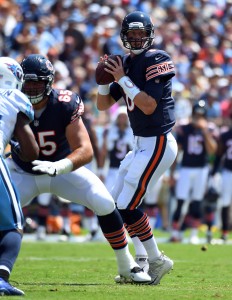 For now, Glennon will have another chance to show he can be an NFL starter. A recurring subject of trade rumors in recent years, the former Buccaneers third-round pick will throw more passes in Week 1 than he did in the past two seasons combined. But in less than two months, Glennon reverted to lame-duck status. Only instead of having the opportunity to display his qualifications for a starting job over the course of a sizable work sample (18 starts for the Bucs from 2013-14), the 27-year-old passer may not have much job security in his new city.
For now, Glennon will have another chance to show he can be an NFL starter. A recurring subject of trade rumors in recent years, the former Buccaneers third-round pick will throw more passes in Week 1 than he did in the past two seasons combined. But in less than two months, Glennon reverted to lame-duck status. Only instead of having the opportunity to display his qualifications for a starting job over the course of a sizable work sample (18 starts for the Bucs from 2013-14), the 27-year-old passer may not have much job security in his new city.
Bears fans witnessed a player with high-end tools deliver middling production for nearly a decade, but Glennon’s post-Jay Cutler audition might not even last through 2017. His guarantee pretty much tethers him to the Bears for this season alone, and Mitch Trubisky will be expected to assume command by 2018. The situation makes sense for the Bears, to some degree, in bringing in an average quarterback to run a team with low expectations while the hopeful prodigy learns. But a Brian Hoyer re-up may have been more reasonable for continuity purposes instead of authorizing a near-$20MM guarantee to a UFA who clearly isn’t in the long-term plans.
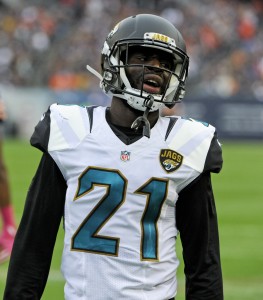 Many Bears UFA deals were not needle-movers, with the franchise striking out on some big-money targets — from A.J. Bouye to Stephon Gilmore to an Alshon Jeffery re-signing — and the franchise instead spent money on several second-tier acquisitions. This took place at both cornerback and wide receiver.
Many Bears UFA deals were not needle-movers, with the franchise striking out on some big-money targets — from A.J. Bouye to Stephon Gilmore to an Alshon Jeffery re-signing — and the franchise instead spent money on several second-tier acquisitions. This took place at both cornerback and wide receiver.
Amukamara’s been a solid defender, albeit an injury-prone one, since coming into the league. The seventh-year man showed he could stay relatively healthy last season by playing 14 Jaguars games. The 28-year-old accepted another one-year pact and will be expected to lead Chicago’s corner corps. Cooper has not shown nearly the consistency his newly arriving counterpart has and was a nonfactor in Kansas City for much of his time there. Pro Football Focus graded Cooper — his four interceptions notwithstanding — as a bottom-10 corner last season with the Cardinals.
No cornerback prospects reside in the team’s pipeline, so the franchise could have to start over again in 2018 — especially after not picking up Kyle Fuller‘s fifth-year option.
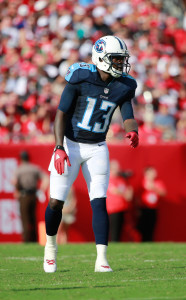 With Cameron Meredith out for the year, the situation is just as strange now at wide receiver.
With Cameron Meredith out for the year, the situation is just as strange now at wide receiver.
In lieu of convincing Jeffery to stay, the Bears went bargain shopping and will be relying on two buy-low options in Wheaton and Wright. Despite lacking the kind of numbers Wright put up with Jake Locker, the former Steelers supporting-caster received the bigger commitment of the two. Wright compiled nearly a 1,100-yard season under now-Bears OC Dowell Loggains with the 2013 Titans and has upside after being marginalized in Tennessee the past two seasons.
Wheaton’s struggled with injuries this offseason and missed 13 games in his contract year. While he did fare decently with the 2015 Steelers (17.0 yards per catch, five touchdown grabs), Wheaton not having the benefit of Antonio Brown could limit his Chicago prospects.
Should Kevin White be unable to stay healthy for a third straight season, Chicago may be forced to retool here in ’18. Instead of deploying wideouts who could grow alongside Trubisky, the Bears have placed some veterans that fit Glennon’s timetable more. (Although, to be fair, Meredith profiled as an ascending talent pre-injury.)
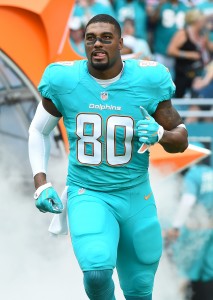 The Bears also have a veteran-laden tight end assembly, with a Zach Miller/Sims combination occupying this spot while Adam Shaheen develops. Sims showed little as a receiver with the Dolphins and is not coming off a season where he displayed much in the run-blocking department — at least, not in the view of PFF — and his contract parallels Glennon’s in being basically a one-year commitment. Virtually no guarantees exist on Sims’ deal in 2018 or ’19, so he’ll have to show more this season than he did during his first four (699 career receiving yards).
The Bears also have a veteran-laden tight end assembly, with a Zach Miller/Sims combination occupying this spot while Adam Shaheen develops. Sims showed little as a receiver with the Dolphins and is not coming off a season where he displayed much in the run-blocking department — at least, not in the view of PFF — and his contract parallels Glennon’s in being basically a one-year commitment. Virtually no guarantees exist on Sims’ deal in 2018 or ’19, so he’ll have to show more this season than he did during his first four (699 career receiving yards).
In not becoming a full-time starter until his age-30 season, Demps has traversed a unique career arc. The former Eagles and Texans backup and part-time starter with the Giants and Chiefs became a solid back-line defender upon returning to Houston. PFF rated Demps as its No. 10 safety in 2016, when he intercepted a career-high six passes. Based on recent production, the Bears did well to sign Demps for less than $5MM guaranteed. But he’s now 32 and may have delivered his best work already. Nevertheless, Demps is a proven safety who should help Chicago in the short term.
Read more
Notable losses:
- Mike Adams, T
- Matt Barkley, QB
- Brandon Boykin, CB
- Jay Cutler: Released, then retired
- Cornelius Edison: Waived
- David Fales, QB
- Jacoby Glenn, CB: Waived
- Brian Hoyer, QB
- Demontre Hurst, CB
- Alshon Jeffery, WR
- Ted Larsen, OL
- Paul Lasike, FB: Waived
- Matt McCants, T
- Logan Paulsen, TE
- Tracy Porter, CB: Released
- Eddie Royal, WR: Released
- Will Sutton, DL: Waived
- Cornelius Washington, DE
- Marquess Wilson, WR
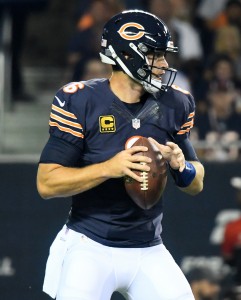 The Bears prying Cutler away from the Broncos seemed like a win in 2009, with franchise quarterbacks rarely changing teams and the then-25-year-old passer coming off a Pro Bowl berth. But the Bears either did not receive the player they thought they were getting, or the Cutler/Mike Shanahan divorce had seminal ramifications for the once-promising passer’s career. Cutler made zero Pro Bowls with Chicago but collected over $101MM during his Bears run, one that produced one playoff berth.
The Bears prying Cutler away from the Broncos seemed like a win in 2009, with franchise quarterbacks rarely changing teams and the then-25-year-old passer coming off a Pro Bowl berth. But the Bears either did not receive the player they thought they were getting, or the Cutler/Mike Shanahan divorce had seminal ramifications for the once-promising passer’s career. Cutler made zero Pro Bowls with Chicago but collected over $101MM during his Bears run, one that produced one playoff berth.
Chicago will start over again at quarterback. While Cutler turned out better than the Bears’ recent first-round quarterback investments before him, he did not deliver on the promise he showed in Denver. Adding to the unlikely outcome of the seminal trade, the Broncos used the picks acquired (with Demaryius Thomas and Eric Decker acquired as a result of the Cutler swap) to help coax Cutler’s eventual franchise-passer replacement, Peyton Manning, to sign in Denver.
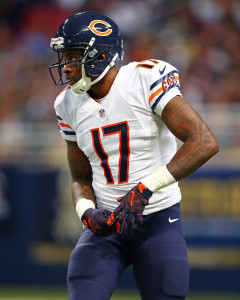 Cutler’s top mid-2010s target, Jeffery was not interested in coming back to the Bears. While soft-tissue injuries and a PED suspension dogged the former second-round pick-turned-franchise-tagged player, Jeffery was a legitimate No. 1 wide receiver. The Bears have now lost two of those in three years, in trading Brandon Marshall — who delivered a Pro Bowl slate with the 2015 Jets — and watching Jeffery sign with the Eagles.
Cutler’s top mid-2010s target, Jeffery was not interested in coming back to the Bears. While soft-tissue injuries and a PED suspension dogged the former second-round pick-turned-franchise-tagged player, Jeffery was a legitimate No. 1 wide receiver. The Bears have now lost two of those in three years, in trading Brandon Marshall — who delivered a Pro Bowl slate with the 2015 Jets — and watching Jeffery sign with the Eagles.
Despite playing just five seasons with the 95-year-old franchise, Jeffery is the team’s third-leading wideout. He and Marshall are responsible for four of the team’s top eight receiving-yardage seasons, so March’s defection signaled a critical point on the franchise’s timeline.
Hoyer and Barkley each trekked to San Francisco, but the 49ers cut Barkley. Hoyer played well for the Bears, and the team met with the quarterback’s reps just before free agency. Although, he was reportedly a mere fallback option for the Bears. Hoyer bolted quickly to sign a more team-friendly deal than Glennon received. Hoyer completed 67 percent of his passes in six games last season and has delivered better work than Glennon, but he signed for just $12MM over two years.
Trades:
- Acquired a 2017 first-round pick (No. 2; QB Mitch Trubisky) from the 49ers in exchange for a 2017 first-round pick (No. 3; DL Solomon Thomas), a 2017 third-round pick (No. 67), a 2017 fourth-round pick (No. 111), and a 2018 third-round pick.
- Acquired a 2017 second-round pick (No. 45; TE Adam Shaheen), a 2017 fourth-round pick (No. 119; RB Tarik Cohen), a 2017 sixth-round pick (No. 197), and a 2018 fourth-round pick from the Cardinals in exchange for a 2017 second-round pick (No. 36; S Budda Baker) and a 2017 seventh-round pick (No. 221).
- Acquired a 2017 fourth-round pick (No. 112; S Eddie Jackson) from the Rams in exchange for a 2017 fourth-round pick (No. 117; WR Josh Reynolds) and a 2017 sixth-round pick (No. 197).
The trade for Trubisky shocked most observers, and it was clearly a solid move for the 49ers in picking up three draft choices to move down one spot. The Browns were rumored to be enamored with the Cleveland-area product, but it would have taken a lot for them to move into the position of holding the Nos. 1-2 picks. It’s unclear who the Bears were negotiating against here.
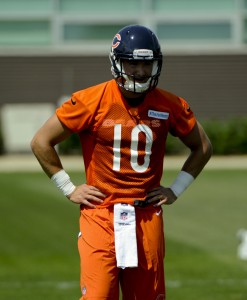 Nevertheless, Trubisky — a one-year starter at North Carolina — being what Ryan Pace and Co. hope for would make the trade-up cost irrelevant. Of course, plenty of doubt exists about that. This selection reportedly expanded the divide between Pace and John Fox, with the former more likely to see the Trubisky era through than the latter, but the duo will be tasked with making this unique arrangement work for now.
Nevertheless, Trubisky — a one-year starter at North Carolina — being what Ryan Pace and Co. hope for would make the trade-up cost irrelevant. Of course, plenty of doubt exists about that. This selection reportedly expanded the divide between Pace and John Fox, with the former more likely to see the Trubisky era through than the latter, but the duo will be tasked with making this unique arrangement work for now.
But the Bears not being expected to compete for the playoffs this season will make it tempting to test the latest quarterback-in-waiting. Trubisky has now surpassed Sanchez on the depth chart, moving him closer to that impending ascent. While the plan remains to roll with Glennon and let Trubisky develop from the sideline, Pace acknowledged the former Tar Heels talent has made steady strides.
Chicago’s been one of the worst modern franchises at identifying quarterback talent. Denver’s 2006 first-round pick, Cutler outdid the work of Rex Grossman (Round 1, 2003) and Cade McNown (R1, 1999). Trubisky enters the Windy City with less of a collegiate pedigree than those signal-callers. While much of Trubisky’s future supporting cast is not yet known, he should see the field at some point this season with an older skill-position contingent. This might not do much for rapport-building, but having the likes of Wright and Miller around could provide some key safety nets while the 23-year-old learns.
Draft picks:
 Interestingly, the Bears supplemented their raw passing prospect with a slew of small-school talents. Shaheen represents the incredibly rare Division II performer who left school early. Initially a Division II basketball player at Pittsburgh-Johnstown University (Pa.), the 6-foot-6, 278-pound pass-catcher transferred to Ashland (Ohio) and caught 70 passes in 2015 and set a program record with 16 touchdown receptions a year later.
Interestingly, the Bears supplemented their raw passing prospect with a slew of small-school talents. Shaheen represents the incredibly rare Division II performer who left school early. Initially a Division II basketball player at Pittsburgh-Johnstown University (Pa.), the 6-foot-6, 278-pound pass-catcher transferred to Ashland (Ohio) and caught 70 passes in 2015 and set a program record with 16 touchdown receptions a year later.
Shaheen’s timetable lines up with Trubisky’s, with the massive tight end set to open the season behind Sims and Miller on the depth chart. Shaheen’s development may be overshadowed, like just about every other aspect of the 2017 Bears not involving, by what happens at quarterback. But the raw talent’s seasoning will worth observing since he’s being groomed to take over soon at this position.
Cohen’s arrival helped force Jeremy Langford off the roster. The diminutive back blended in with the franchise’s draft profile heavy on non-Division I-FBS prospects, but the 5-7 runner could be summoned to action early this season. Unlike Shaheen, he profiles as a backup, however.
The Bears’ recent safety investments profile as about the only young talent for fans to observe in this secondary this season, and Jackson appears to have usurped 2015 fifth-rounder Adrian Amos. The Bears have the former Crimson Tide starter atop their Week 1 depth chart — ahead of Amos and 2016 fourth-rounder Deon Bush.
Extensions and restructures:
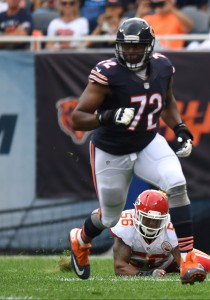 While Leno may not be a well-known NFL commodity in toiling for some off-the-grid Bears teams, the left tackle is now a big part of the franchise’s future. Soon to be 26, Leno will begin his third season as a Bears starter and do so having made the rise from seventh-round pick to a player earning upper-echelon offensive line money. Pro Football Focus graded Leno as its No. 42 tackle last season, and his 2016 work proved enough for the Bears to commit before the edge blocker’s contract year.
While Leno may not be a well-known NFL commodity in toiling for some off-the-grid Bears teams, the left tackle is now a big part of the franchise’s future. Soon to be 26, Leno will begin his third season as a Bears starter and do so having made the rise from seventh-round pick to a player earning upper-echelon offensive line money. Pro Football Focus graded Leno as its No. 42 tackle last season, and his 2016 work proved enough for the Bears to commit before the edge blocker’s contract year.
The ex-Boise State cog now earns $9.25MM annually. The deal ties Leno to the Bears for at least the next two seasons and makes him a top-15 tackle in terms of per-year average — ahead of Jason Peters, Duane Brown, Jared Veldheer and Donald Penn by this measurement. Leno’s contract keeps him under Bears control for five more seasons, joining Kyle Long (signed through 2021) and Cody Whitehair (through 2019) as cornerstones.
Other:
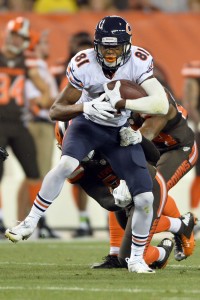 Chicago’s offseason cornerback pursuits and eventual signings continue to point to the organization having a low opinion of Fuller, who is now entering a contract year. He missed all of last season with a shoulder injury and was rumored to be available for a late-round pick this offseason. Stranger breakouts have occurred, however, and the Bears could use Fuller to belatedly show he can be a key part of their secondary. Because the cornerback contingent does not presently have much on which to build.
Chicago’s offseason cornerback pursuits and eventual signings continue to point to the organization having a low opinion of Fuller, who is now entering a contract year. He missed all of last season with a shoulder injury and was rumored to be available for a late-round pick this offseason. Stranger breakouts have occurred, however, and the Bears could use Fuller to belatedly show he can be a key part of their secondary. Because the cornerback contingent does not presently have much on which to build.
The Meredith setback will cause the Bears’ UFA signings and White to play bigger roles. A 2015 UDFA, Meredith took an unlikely route to becoming Chicago’s No. 1 receiver. But it will be a while before he can hold that title again. White has missed 28 of a possible 32 games in his career, and while the ex-West Virginia standout remains a key part of this passing attack due largely to that No. 7 overall draft status, he has been one of the least productive first-round receivers in memory across his first two seasons. Meredith’s injury opens the door for White, but it hurts the Bears’ aerial operation considerably.
Top 10 cap charges for 2017:
- Mike Glennon, QB: $14,000,000
- Kyle Long, G: $8,000,000
- Pernell McPhee, LB: $7,825,000
- Prince Amukamara, CB: $7,000,000
- Lamarr Houston, LB: $6,990,000
- Danny Trevathan, LB: $6,850,000
- Josh Sitton, G: $6,822,916
- Akiem Hicks, DL: $6,200,000
- Bobby Massie, T: $6,034,375
- Dion Sims, TE: $5,333,333
Chicago’s offseason may have been a bit uneven, and its roster might be operating on mismatched timelines, but the Bears chucking their long-held status quo profiled as one of this year’s most interesting stories. The Bears’ Glennon games may not be especially captivating, but should Trubisky usurp the starter this season as many expect, the dawn of the next era will be worth monitoring to see if the quarterback-starved franchise finally made the right call.
For now, the wait until the Trubisky run begins for a fanbase that hasn’t seen its team make the playoffs in seven years.
Information from Over the Cap and Roster Resource was used in the creation of this post. Photos courtesy of USA Today Sports Images.
By Zachary Links |
at September 5, 2017 9:53 pm
The Jets swear up and down that they aren’t tanking, but if they’re not trying to secure the first pick in the 2018 draft, then we’re not quite sure what the game plan is. Recently, former head coach Rex Ryan became the latest to pile on Gang Green’s offseason.
“They have to get a quarterback,” Ryan told ESPN.com’s Rich Cimini. “That kid from Penn State, we all know that’s not the answer.”
That kid, Christian Hackenberg, was taken in the second round of last year’s draft with the hope that he would blossom into the team’s next franchise QB. He did not see a snap as a rookie and this year he is third on the depth chart behind a 38-year-old journeyman and a former fourth-round pick with limited NFL experience.
The question marks go far beyond the quarterback position. The Jets are a team with no real prospects for the 2017 season and no exact blueprint for the future. However, if the Jets can secure the No. 1 pick (which is totally not their goal, you guys), then there will be some reason for hope.
Notable signings:
- Brian Winters, G: Four years, $29MM. $15MM guaranteed.
- Kelvin Beachum, T: Three years, $24MM. $12MM guaranteed.
- Josh McCown, QB: One year, $6MM. Fully guaranteed. $7MM available via incentives.
- Ben Ijalana, T: Two years, $10.25MM. $3MM guaranteed.
- Morris Claiborne, CB: One year, $5MM. $2MM signing bonus.
- Josh Martin, LB: Two years, $3.8MM. $850K guaranteed.
- Chandler Catanzaro, K: One year, $900K. $250K guaranteed.
- Bruce Carter, LB: One year, minimum salary benefit. $80K guaranteed.
- Jonotthan Harrison, C: One year, $850K. $50K guaranteed.
- Mike Pennel, DT: One year, $990K.
- Wesley Johnson, C: One year, $2.746MM. Signed second-round RFA tender.
- Marcus Williams, CB: One year, $2.746MM. Signed second-round RFA tender.
- Jeremy Kerley, WR: One year, contract terms unknown.
Josh McCown had opportunities to serve as a No. 2 quarterback for contending teams, but he followed the money to New York where he’ll enter as the Week 1 starter. McCown didn’t have a ton of competition for the job this summer given Hackenberg’s aforementioned struggles and Bryce Petty‘s knee injury, but he’ll probably get the hook if/when the Jets fall in the standings. Eventually, the Jets have to get a better read on what Petty can offer and they’ll have to test Hackenberg in some fashion. 
The good news for the Jets’ QB trio is that the team did invest a bit in the offensive line. One of last year’s most porous units now has Kelvin Beachum starting at left tackle, and he could be a difference maker if he’s healthy. The 28-year-old was an elite left tackle in 2014 with the Steelers. In 2015, he had his season cut short by a torn ACL and could not get back to his old form upon joining the Jaguars in 2016. Last year he graded out as the NFL’s No. 63 tackle among 78 qualifiers, per Pro Football Focus, and one has to wonder if the knee injury was holding him back. Last year’s left tackle, Ben Ijalana, will slide back over to the right side after re-upping on a two-year deal.
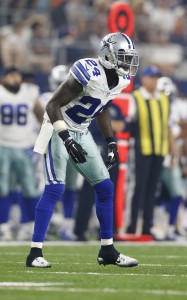 The Jets made a low-risk/high-reward signing by adding cornerback Morris Claiborne in March. There’s just one problem here – what good will it do the Jets to have a quality cornerback on a one-year deal when the rest of the team is not equipped to win? Then again, if the Jets wanted to add a second or third year to the deal, it would have cost them a pretty penny. The Claiborne deal came in at just $5MM for this year and that will be a steal if Claiborne can perform like he did in his injury-shorted 2016 campaign. Claiborne was on the field for only seven games, but he finished out as Pro Football Focus’ 12th ranked corner for his work in Dallas. If he plays well, it’s possible that the Jets will re-sign him to a long-term deal, allowing him to be a part of the franchise’s turnaround.
The Jets made a low-risk/high-reward signing by adding cornerback Morris Claiborne in March. There’s just one problem here – what good will it do the Jets to have a quality cornerback on a one-year deal when the rest of the team is not equipped to win? Then again, if the Jets wanted to add a second or third year to the deal, it would have cost them a pretty penny. The Claiborne deal came in at just $5MM for this year and that will be a steal if Claiborne can perform like he did in his injury-shorted 2016 campaign. Claiborne was on the field for only seven games, but he finished out as Pro Football Focus’ 12th ranked corner for his work in Dallas. If he plays well, it’s possible that the Jets will re-sign him to a long-term deal, allowing him to be a part of the franchise’s turnaround.
Read more
Notable losses:
- Antonio Allen, S
- Braedon Bowman, TE: Waived
- Brandon Bostick, TE
- Mike Catapano, DL
- Ryan Clady, T: Team declined option, Clady retired
- Kellen Davis, TE
- Eric Decker, WR: Released
- Ryan Fitzpatrick, QB
- Nick Folk, K: Released
- Breno Giacomini, T: Released
- Marcus Gilchrist, S: Released
- David Harris, LB: Released
- Erin Henderson, LB: Team declined option
- Nick Mangold, C: Released
- Brandon Marshall, WR: Released
- Darrelle Revis, CB: Released
- Khiry Robinson, RB: Waived
- Geno Smith, QB
Given the Jets’ extended timetable for getting back to winning football, it made some sense for them to release wide receiver Eric Decker and linebacker David Harris. The timing, however, was not ideal. Both players were released in June, long after the bulk of the free agent dollars had dried up. The good news for them is that they both found decent landing spots. Decker will play his home games near his family in Nashville, Tennessee while Harris will chase a Super Bowl ring with the Patriots. 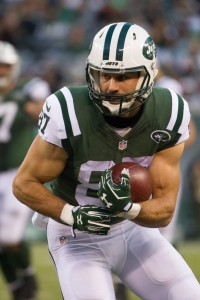
Unlike Decker, Brandon Marshall actually secured his release in March. Marshall used that opportunity to join up with the other tenant of the Meadowlands, signing a two-year, $12MM deal with the G-Men. Marshall could put up some real numbers as Odell Beckham Jr. draws the attention of opposing secondaries.
The Jets cut ties with their longest-tenured player when they released Nick Mangold in February. The veteran center missed half of the season due to injury and his ongoing unemployment underscores the harsh reality that he is no longer a top flight center. By cutting the former first-round pick, the Jets saved more than $9MM. With the early offseason releases of Ryan Clady, Breno Giacomini, Nick Folk, and Mangold, the Jets cleared a whopping $26.575MM off the 2017 cap.
After that quartet of veterans were shown the door, the Jets had a tough decision to make on Darrelle Revis. In a fit of nostalgia, owner Woody Johnson brought Revis Island back to New York with a five-year, $70MM pact prior to the 2015 season. Two years later, the critics were proved right as the Jets released Revis. The move was more football/culture driven than financial. Cutting Revis saved $9.3MM in cap space, but the Jets are still on the hook for $6MM in guaranteed base pay for 2017. Because of the offset language in the deal, Revis has refused to sign with any other club for less than that sum since he’d effectively be playing for free. No team will meet that salary demand since Revis is a shell of his former self, but we could conceivably see him return to the NFL for some team’s playoff run.
Ryan Fitzpatrick and the Jets were in a high-profile contract standoff last offseason. Ultimately, Fitzpatrick got a one-year, $12MM deal out of the Jets in late July, even though the Jets were basically bidding against themselves. Unfortunately, the veteran regressed sharply from his 2015 performance, leading to his exit this summer. The Jets’ QB situation is a bit of a quagmire now, but no one was calling for Fitzmagic to fix it this time around. He’ll now serve as Jameis’ Winston’s backup in Tampa.
Many of the team’s familiar faces were discarded this offseason, but the Jets do have Jeremy Kerley back in the fold. A surprise cut of the Niners in early September, Kerley figures to be one of the team’s leading receivers this year.
Trades:
Last offseason, the Jets gave Muhammad Wilkerson a lucrative extension that likely sealed Sheldon Richardson‘s fate. Rather than lose Richardson for nothing next spring, the Jets pulled the trigger on a blockbuster deal on Sept. 1 to add to their draft stockpile. The Jets are losing one of the game’s most talented defensive linemen, but they’re gaining a second-round selection that can help them win games when it will actually matter for them. And, in the interim, veteran wide receiver Jermaine Kearse will help to round out a paper thin unit.
The Jets made a few other trades of note, reuniting with Demario Davis by sending hard-hitting Louisville product Calvin Pryor to Cleveland. The Jets sent another one-time Ryan favorite out of town when they acquired cornerback Dexter McDougle to the Eagles for safety Terrence Brooks.
Extensions and restructures:
Draft picks:
The Jets took criticism for a lot of their decisions this offseason, but they were largely applauded for their selection of LSU safety Jamal Adams at No. 6 overall. Adams is as NFL-ready as they come and marks a clear upgrade to the secondary. The reviews are a little more mixed on second-round pick Marcus Maye, but GM Mike Maccagnan made a name for himself as a college scout. It was his foresight that built the Texans’ stellar defense and he believes he is planting the seeds for something similar with his top picks in this year’s draft.
Other:
A freak accident in practice left top receiver Quincy Enunwa with a season-ending neck injury. The Jets will now have to wait until 2018 to get him back on the field and that’s soul crushing since he profiled as the team’s top offensive weapon for this year.
The Jets also have some suspensions to deal with on offense and they’ll have to start their year without tight end Austin Seferian-Jenkins and wide receiver Jalin Marshall. The good news is that ASJ drew rave reviews throughout training camp and there’s reason to believe that he could have a strong year as one of McCown’s most-targeted players.
Top cap charges for 2017:
- Muhammad Wilkerson, DL: $18,000,000
- Buster Skrine, CB: $8,500,000
- Brian Winters, G: $8,000,000
- James Carpenter, G: $6,805,000
- Josh McCown, QB: $6,500,000
- Darrelle Revis, CB: $6,000,000 (dead money)
- Leonard Williams, DL: $5,081,146
- Kelvin Beachum, T: $5,000,000
- Ryan Fitzpatrick, QB: $5,000,000 (dead money)
Ultimately, the success of this year’s Jets team will not be determined by the win/loss column. If the Jets can see some quality performances from their younger players while winding up with their quarterback of the future in the 2018 draft, they will be better positioned for the future.
Information from Over the Cap and Roster Resource was used in the creation of this post. Photos courtesy of USA Today Sports Images.
By Dallas Robinson |
at August 31, 2017 4:35 pm
The 49ers have been a mess since Jim Harbaugh left for Michigan following the 2014 campaign, but the club is perhaps finally getting back on track. With a new general manager and head coach in place, San Francisco spent the offseason rebuilding from the ground up.
Notable signings:
- Pierre Garcon, WR: Five years, $47.5MM. $17MM guaranteed.
- Malcolm Smith, LB: Five years, $26.5MM. $11.5MM guaranteed.
- Brian Hoyer, QB: Two years, $12MM. $9.85MM guaranteed. $6.5MM available via incentives.
- Kyle Juszczyk, FB: Four years, $21MM. $7MM guaranteed.
- Earl Mitchell, DT: Four years, $16MM. $4.65MM guaranteed.
- Marquise Goodwin, WR: Two years, $6MM. $4.45MM guaranteed.
- Jeremy Kerley, WR: Three years, $8.4MM. $2.8MM guaranteed.
- Elvis Dumervil, DE: Two years, $8MM. $1.5MM guaranteed.
- Garry Gilliam, T: One year, $2.2MM. $1.25MM guaranteed. Seahawks declined to match 49ers RFA offer sheet.
- Dekoda Watson, LB: Three years, $4.5MM. $1MM guaranteed.
- Robbie Gould, K: Two years, $4MM. $1MM guaranteed.
- Don Jones, S: Two years, $2.2MM. $750K guaranteed.
- Matt Barkley, QB: Two years, $4MM. $500K guaranteed.
- Aldrick Robinson, WR: Two years, $4MM. $500K guaranteed. $2MM available via incentives.
- Brock Coyle, LB: One year, $1.45MM. $400K guaranteed.
- Tim Hightower, RB: One year, $1.107MM. $300K guaranteed. $400K available via incentives.
- Logan Paulsen, TE: One year, $1MM. $125K guaranteed.
- K’Waun Williams, CB: One year, $765K. $75K guaranteed. $250K available via incentives.
- Chris Jones, DT: One year, minimum salary benefit. $50K guaranteed.
- Tim Barnes, C: One year, $795K. $20K guaranteed.
- Brandon Fusco, G: One year, $1.4MM.
- Shayne Skov, LB: One year, $615K.
- Will Davis, CB: One year, minimum salary benefit.
- Leger Douzable, DT: One year, minimum salary benefit.
- Andrew Gardner, OL: One year, minimum salary benefit.
- Asa Jackson, CB: One year, minimum salary benefit.
- Sen’Derrick Marks, DT: One year, minimum salary benefit.
- Louis Murphy, WR: One year, minimum salary benefit.
With a new regime lead by head coach/offensive mastermind Kyle Shanahan in place, the 49ers nearly revamped the entirety of their offensive skill positions during the free agent period. That effort started with the signings of quarterbacks Brian Hoyer and Matt Barkley, who will likely serve as San Francisco’s No. 1 and No. 2 options under center in 2017. The 49ers figure to target a signal-caller upgrade in the coming year, either through an early draft choice or a pursuit of a free agent quarterback such as Kirk Cousins, but a Hoyer/Barkley tandem is a serviceable duo for a rebuilding club, especially given the limited price tag. Hoyer, of course, has worked with Shanahan before, passing for more than 3,000 yards, 12 touchdowns, and 13 interceptions under the then-Browns play-caller in 2014. While the 31-year-old performed much better in 2016 (no interceptions on 200 pass attempts), Hoyer finished 26th in air yards per attempt among quarterbacks with at least five starts, meaning his success was mostly based around short throws.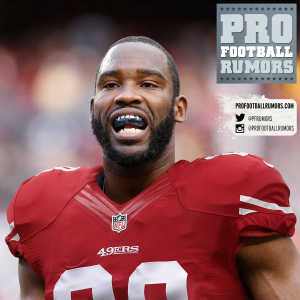
Hoyer will be tossing the ball to a wide receiver crew that’s almost entirely new, and is now led by Pierre Garcon. Like Hoyer, Garcon has played for Shanahan in the past, as he lead the NFL in receptions with the Redskins in 2013 while Shanahan was the club’s offensive coordinator. While Garcon may not be a clear-cut No. 1 wideout any more at the age of 31, he’ll serve in that capacity for the 49ers, especially given that he’s familiar with the team’s new offensive scheme. It won’t be a surprise if he improves upon his 114 targets from a season ago, and the club will value his leadership and toughness. San Francisco didn’t stop after adding Garcon, however, as the club also signed Marquise Goodwin, Aldrick Robinson, and Louis Murphy while re-upping Jeremy Kerley. Goodwin is the most intriguing of the bunch, as he’s a former Olympian who ran a 4.27-second 40-yard dash at the 2013 combine. Ideally, that would make Goodwin a near-perfect option to play the Taylor Gabriel/deep threat role in Shanahan’s offense.
San Francisco’s backfield also saw a makeover headlined by the additions of running back Tim Hightower and fullback Kyle Juszczyk. Hightower is 31 years old, but he doesn’t have the wear-and-tear of a normal running back of that age given that he didn’t play in the NFL from 2012-14 (all told, he’s only rushed 752 times during his pro career). While he should be able to help in the passing game, Hightower could have trouble running behind the 49ers’ sub-par offensive line — according to the 2017 Football Outsiders Almanac, Hightower broke a tackle on only 7.8% of his touches, second-worst in the league. Juszczyk, meanwhile, signed one of the more above-market deals in recent memory, as he blew away all fullback precedents with a $5.25MM annual salary that is more than double the next fullback. The deal is a complete overpay, but Shanahan knows how to deploy fullbacks (see: Patrick DiMarco in 2016), and San Francisco had cap space to burn.
The 49ers used that ample cap space to ink a number of veterans to low-cost contracts (whether that be minimum salary benefit deals or just pacts with little-to-no guaranteed money). Never was that more apparent that along the offensive line, where San Francisco signed Tim Barnes, Brandon Fusco, Andrew Gardner, and Garry Gilliam, the latter of whom was poached from the division-rival Seahawks in restricted free agency. None of those players is a superstar, and they may not all even make the Niners’ 53-man roster. But they’ll give the club some semblance of respectability up front — Fusco, notably, is now on track to start at right guard while Barnes could conceivably see time at center in place of Daniel Kilgore. Barnes, Fusco, and Gilliam combined to start 43 games in 2016.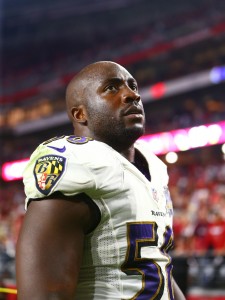
Taking chances on cheap players was also a tactic for San Francisco on the defensive side of the ball (cornerback K’Waun Williams, defensive linemen Chris Jones and Leger Douzable), but the club also brought in a number of defenders who should definitely stick on the roster. The 49ers’ defensive line was specifically addressed, as the team signed defensive tackles Earl Mitchell and Sen’Derrick Marks plus edge rusher Elvis Dumervil. Mitchell should anchor the interior of San Francisco’s defensive front, playing the nose tackle role alongside three-technique DeForest Buckner, while Marks can offer a bit of pass rush on an interior rotation. Dumervil, though, is potentially the most interesting addition, as the 33-year-old came on in 2016 after returning from a foot injury — in the last five weeks of the season, Dumervil managed 22 total pressures (sixth among edge defenders), per Pro Football Focus.
Read more
Notable losses:
- Nick Bellore, LB
- Antoine Bethea, S: Released
- Carl Bradford, LB: Waived
- Tramaine Brock, CB: Released
- Ahmad Brooks, LB: Released
- Chris Davis, CB
- Mike Davis, RB: Waived
- Phil Dawson, K
- Glenn Dorsey, DL
- Shaun Draughn, RB
- Jim Dray, TE
- Bruce Ellington, WR: Waived
- Blaine Gabbert, QB
- Gerald Hodges, LB
- Tony Jerod-Eddie, DL
- Colin Kaepernick, QB: Player opt out
- Thad Lewis, QB
- Quinton Patton, WR
- Mike Purcell, DT: Waived
- Torrey Smith, WR: Released
- Rod Streater, WR
- Andrew Tiller, OL
- Michael Wilhoite, LB
- Jeremy Zuttah, C: Released
A multitude of new offensive players in San Francisco meant the club needed to cut ties with a number of incumbents, and that list starts with quarterbacks Colin Kaepernick and Blaine Gabbert. We’re not going rehash Kaepernick’s entire history of social activism and his decision to kneel for the national anthem in 2016, as there’s no indication either ultimately led to him leaving the 49ers. Kaepernick made the decision to opt out of his contract after it was clear general manager John Lynch & Co. would release him if he didn’t do so, a call that was mostly performance- and salary-based. Once San Francisco made the decision to pursue Brian Hoyer, it simply didn’t make sense to retain Kaepernick and his nearly $15MM cap charge. Gabbert, too, wasn’t asked to return after completing only 57% of his passes in five starts.
The turnover continued at the skill positions, where running back Shaun Draughn and wide receivers Torrey Smith, Quinton Patton, Bruce Ellington, and Rod Streater are now gone. Patton led that group in offensive snaps (701), but he only managed 37 receptions and a 58.7% catch rate. Smith performed even worse (just 20 catches), and was subsequently released following two disastrous years in the Bay Area. Signed to a five-year, $40MM deal prior to the 2015 campaign, Smith never found a place in the 49ers’ offense, averaging only 26 receptions per season while scoring just seven total touchdowns (he scored 11 times in 2014, his final campaign in Baltimore). Draughn, meanwhile, has always been a reliable receiving back, but that’s a role that will taken by Tim Hightower and/or Matt Breida in 2017.
On the defensive side of the ball, the 49ers cut bait with a cadre of linebackers: Ahmad Brooks, Gerald Hodges, Michael Wilhoite, and Nick Bellore were all either released or allowed to leave via free agency. Brooks was cut over the weekend in a move that made sense for multiple reasons, namely Brooks’ age (33) and the fact that he hasn’t ranked as a top-20 edge option per PFF since 2012. A case could be made that San Francisco should have made more of an effort to retain either Hodges or Bellore, as both landed only minimum salary contracts this offseason. Hodges is only 26 years old and was excellent on 583 defensive snaps last season, while Bellore is a standout special teams player.
Changes also came to the 49ers’ secondary, where the club parted ways with cornerback Tramaine Brock following domestic violence allegations. Brock eventually saw his charges dropped, but San Francisco — which was reportedly interested in extending Brock before the claims surfaced — had already released him. While the Niners may have acted too quickly, it’s difficult to judge their decision to cut Brock given the current climate regarding domestic violence. Safety Antoine Bethea is also gone (and, like Brock, is now playing for another NFC West team), but his release was performance-based, as PFF graded him as a the league’s No. 74 safety among 90 qualifiers.
Trades:
- Acquired C Jeremy Zuttah and a 2017 sixth-round pick (No. 198) from the Ravens in exchange for a 2017 sixth-round pick (No. 186).
- Acquired a 2017 first-round pick (No. 3; DL Solomon Thomas), a 2017 third-round pick (No. 67), a 2017 fourth-round pick (No. 111), and a 2018 third-round pick from the Bears in exchange for a 2017 first-round pick (No. 2; QB Mitch Trubisky).
- Acquired a 2017 first-round pick (No. 31; LB Reuben Foster) from the Seahawks in exchange for a 2017 second-round pick (No. 34) and a 2017 fourth-round pick (No. 111; S Tedric Thompson).
- Acquired a 2017 seventh-round pick (No. 229; CB Adrian Colbert) and a 2018 second-round pick from the Saints in exchange for a 2017 third-round pick (No. 67; RB Alvin Kamara).
- Acquired a 2017 third-round pick (No. 104; QB C.J. Beathard) from the Vikings in exchange for a 2017 fourth-round pick (No. 109; DT Jaleel Johnson) and a 2017 seventh-round pick (No. 219; WR Stacy Coley).
- Acquired RB Kapri Bibbs and a 2017 fifth-round pick (No. 177; WR Trent Taylor) from the Broncos in exchange for a 2018 fourth-round pick.
- Acquired a 2017 fourth-round pick (No. 121; RB Joe Williams) from the Colts in exchange for a 2017 fourth-round pick (No. 143; RB Marlon Mack) and a 2017 fifth-round pick (No. 161; LB Anthony Walker).
- Acquired a 2018 fourth-round pick from the Steelers in exchange for TE Vance McDonald and a 2018 fifth-round pick.
- Acquired G Laken Tomlinson from the Lions in exchange for a 2019 fifth-round pick.
While the 49ers’ trade for center Jeremy Zuttah now looks confusing given that the club has already released him (paving the way for Zuttah to re-sign with Baltimore), the deal had merits at the time it was agreed to. San Francisco was hoping to improve upon Daniel Kilgore, whom PFF ranked as the league’s No. 27 center a season ago, by acquiring Zuttah, whom PFF listed at No. 17. It’s a small separation, to be sure, but the Niners didn’t give up much, as they only dropped down 12 spots in the sixth round to pick up Zuttah. Sure, the deal didn’t work out, but it barely cost San Francisco anything and represented a worthwhile risk.
The Niners were on the other end of a small draft drop in the Vance McDonald trade, as they sent the veteran tight end and a fifth-round pick to the Steelers for a fourth-round choice. Pittsburgh, of course, projects to perform well next season, so its fourth-rounder will likely come near the end of the round, while San Francisco’s fifth-round selection should be at the top of the round. As such, the 49ers may only move up ~10 places in exchange for giving up McDonald, but that’s probably acceptable for the clubs’ new front office, which has been trying to trade McDonald for some time. San Francisco will take on dead money for McDonald in each of the next two years: $1.4MM in 2017 and $4.2MM in 2018.
Through the McDonald trade, San Francisco will recoup the 2018 fourth-round pick it lost as part of the Kapri Bibbs draft-day swap. The Bibbs deal was a strange one from the beginning, as the 49ers gave up a relatively high draft choice next year in exchange for a running back who boasts all of 29 career carries. Perhaps general manager John Lynch & Co. saw an opportunity to add a special teams contributor on the cheap, as Bibbs played on 43.8% of Denver’s special teams snaps in 2016. But given the presence of Tim Hightower, Joe Williams, Matt Breida, and Raheem Mostert, Bibbs isn’t even likely to make the final San Francisco roster.
That’s not the case for former first-round pick Laken Tomlinson, whom the 49ers picked up from the Lions on Thursday. While Tomlinson has started 24 games over his first two years in the NFL, he’s also performed like one of the league’s worst guards. He wasn’t going to earn a roster spot with Detroit, so Lions general manager Bob Quinn did well to get any sort of compensation for him. But that doesn’t mean the deal doesn’t have merit for San Francisco, as well, as taking chances on players with pedigree is always a tenable strategy for rebuilding clubs.
Draft picks:
- 1-3: Solomon Thomas, DL (Stanford)
- 1-31: Reuben Foster, LB (Alabama)
- 3-66: Ahkello Witherspoon, CB (Colorado)
- 3-104: C.J. Beathard, QB (Iowa)
- 4-121: Joe Williams, RB (Utah)
- 5-146: George Kittle, TE (Iowa)
- 5-177: Trent Taylor, WR (Louisiana Tech)
- 6-198: D.J. Jones, DT (Mississippi)
- 6-202: Pita Taumoepenu, DE (Utah)
- 7-229: Adrian Colbert, CB (Miami)
It’s still unclear whether the 49ers actually had other suitors other than the Bears for the No. 2 pick and quarterback Mitch Trubisky, as various reports offered conflicting information. Either way, San Francisco clearly made Chicago believe the second overall selection was in high demand, and the 49ers ultimately collected 154 cents on the dollar (with their 2018 pick acquisition discounted 10% because it’s a future selection) and still came away with one of the draft’s best defensive players in Stanford’s Solomon Thomas. Thomas, who is expected to start immediately in the 49ers’ new 4-3 scheme, led all draft-eligible defenders in Pro Football Focus‘ run defense grading, and also registered a quarterback pressure on one-out-of-ten pass rushing snaps, third in the class.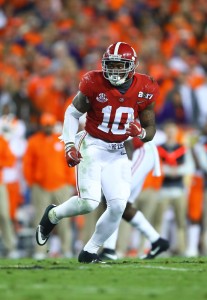
San Francisco would’ve selected linebacker Reuben Foster third overall had Myles Garrett and Thomas already been off the board, but the team eventually got the Alabama defender after trading back into the first round at No. 31. First-year general manager John Lynch may have avoided a critical mistake with Foster, as drafting a player that eventually fell to the end of Day 1 at No. 3 overall would have been a clear error. But that doesn’t mean the 49ers didn’t land an excellent player, and one who’s expected to start now that he’s medically cleared and fellow ‘backer Malcolm Smith is lost for the season. Lance Zierlein of NFL.com says Foster has an “alpha mentality” and compares him to the Seahawks’ Bobby Wagner.
Other 49ers draftees have a chance to make an early-season impact, as well. Fifth-rounder George Kittle, specifically, looks like the club’s starting tight end after the trade of veteran Vance McDonald. Trent Taylor will be an immediate option in the return game, and could see snaps in the slot if Jeremy Kerley falters. Running back Joe Williams is currently behind undrafted rookie Matt Breida and journeyman Raheem Mostert, but the Utah Ute was especially explosive at the combine. Quarterback C.J. Beathard, meanwhile, was considered an overdraft in the third round, but he might be able to beat out Matt Barkley for San Francisco’s backup signal-caller job.
Other:
The 49ers are now on their fourth head coach in as many seasons, and this time around first-time head coach Kyle Shanahan will be joined by another first-timer in general manager John Lynch. San Francisco shocked the NFL world by hiring Lynch, a former player and broadcaster, but the club should be given credit for thinking outside of the box. If the early returns are any indication, Lynch is cut out to be an NFL GM, especially with talent evaluators such as former Broncos staffer Adam Peters by his side.
Shanahan, meanwhile, is widely respected around the league for his offensive calls and innovation (his efforts at the end of Super Bowl LI not withstanding), and he should be able to get the most out of what is currently an underwhelming set of offensive skill position players. His staff is certainly short on experience, however, as none of the San Francisco coaches have ever been a head coach or even a coordinator before. The 49ers won’t hire an offensive coordinator, and Shanahan will lean on a quarterbacks coach in Rich Scangarello who most recently worked at Wagner College, a liberal arts university in New York.
Top 10 cap charges for 2017:
- Joe Staley, T: $11,056,250
- NaVorro Bowman, LB: $9,591,500
- Pierre Garcon, WR: $6,425,000
- Eric Reid, S: $5,676,000
- Brian Hoyer, QB: $5,275,000
- Torrey Smith, WR: $4,800,000 (dead money)
- Vance McDonald, TE: $4,165,625
- DeForest Buckner, DL: $4,134,316
- Zane Beadles, G: $4,033,333
- Kyle Juszczyk, FB: $3,750,000
Could the 49ers be an extremely under-the-radar playoff sleeper in 2017? That’s probably too much to ask just yet, but the club has added enough baseline talent that two wins shouldn’t be the expectation again. While the rebuild in San Francisco could be a slow process (at least until the team finds it long-term quarterback), the 49ers should take a step forward next season.
Information from Over the Cap and Roster Resource was used in the creation of this post. Photos courtesy of USA Today Sports Images.
By Dallas Robinson |
at August 29, 2017 9:40 pm
Another year, another massive disparity between the two sides of the Saints’ roster. 2016 marked the third consecutive season in which New Orleans’ offense ranked as top-seven DVOA unit while the club’s defense finished in the bottom-two by the same metric. Closing that gap was atop general manager Mickey Loomis‘ offseason itinerary.
Notable signings:
- Larry Warford, G: Four years, $34MM. $17MM guaranteed.
- Nick Fairley, DT: Four years, $28MM. $9MM guaranteed. $2MM available via incentives.
- A.J. Klein, LB: Three years, $15MM. $5.7MM guaranteed.
- Adrian Peterson, RB: Two years, $7MM. $3.5MM guaranteed. $8.25MM available via incentives.
- Ted Ginn Jr., WR: Three years, $11MM. $3MM guaranteed.
- Alex Okafor, DE: One year, $2MM. $1MM guaranteed.
- Chase Daniel, QB: One year, $900K. Fully guaranteed. $3MM available via incentives.
- Manti Te’o, LB: Two years, $5MM. $600K guaranteed.
- Chris Banjo, S: Two years, $2.85MM. $200K guaranteed.
- Sterling Moore, CB: One year, $900K. $200K guaranteed.
- Rafael Bush, S: One year, minimum salary benefit. $180K guaranteed.
- Michael Mauti, LB: One year, minimum salary benefit. $125K guaranteed.
- Travaris Cadet, RB: One year, minimum salary benefit. $80K guaranteed.
- John Phillips, TE: One year, minimum salary benefit. $80K guaranteed.
- Darryl Tapp, DE: One year, minimum salary benefit. $60K guaranteed.
- Khalif Barnes, T: One year, minimum salary benefit.
- Bryan Braman, DE: One year, minimum salary benefit.
- Justin Drescher, LS: One year, minimum salary benefit.
- Clay Harbor, TE: One year, minimum salary benefit.
- Bryce Harris, T: One year, minimum salary benefit.
- John Hughes, DT: One year, minimum salary benefit.
- Josh LeRibeus, OL: One year, minimum salary benefit.
- Zach Line, FB: One year, minimum salary benefit.
- Tony McDaniel, DT: One year, minimum salary benefit.
- Ryan Nassib, QB: One year, minimum salary benefit.
While Jahri Evans had made nearly every start at right guard for the Saints over the past decade-plus, that won’t be the case in 2017, as New Orleans agreed to a four-year contract with former Lions lineman Larry Warford. Detroit wasn’t successful in the run-blocking game last season (31st in adjusted line yards), but the club was best at rushing up the middle, as it ranked 20th in ALY on runs over the center or guard. While Warford has never lived up to his standout rookie campaign, he’s been a relatively consistent player of the course of his NFL tenure. And the Saints got a good deal: among the top guards available in 2017 (Warford, Kevin Zeitler, T.J. Lang, and Ronald Leary), Warford is the youngest but received the lowest annual salary and cheapest guarantee.
Running behind Warford and the rest of the New Orleans offensive line will be veteran back Adrian Peterson, who landed with the Saints after the Vikings declined his 2017 option. Peterson, of course, was sidelined for two of the past three seasons, first by a child abuse case and then by a torn meniscus. When he was last healthy in 2015, Peterson lead the league with 1,485 yards rushing and 11 touchdowns, but he’s now 32 years old and could struggle to see work based on his lack of ability in the passing game (both as a receiver and a blocker). Peterson also has trouble running out of the shotgun, but that concern could be mitigated with the Saints, as New Orleans ran the ball out of a shotgun formation on only 13% of plays in 2017, 30th among NFL clubs.
Ted Ginn Jr. is another new addition to the Saints’ offense, and he’ll attempt to replicate the Devery Henderson role — deep pass specialist — with Drew Brees and the rest of the New Orleans passing game. Henderson led the NFL in yards per reception twice during his Saints career, and if Ginn can come close to that level of production, New Orleans will assuredly be pleased. In 2016, Ginn posted seven receptions of 30+ yards, four of which went for touchdowns, but he also has infamously unreliable hands, as he finished 13th in drop rate among wideouts with at least 50 targets.
On the defensive side of the ball, the Saints took another swing at finding an edge rusher to play opposite Cameron Jordan by inking former Cardinal Alex Okafor to a one-year pact. Okafor is still only 26 years old and put up eight sacks as recently as 2014, but he’s posted only 5.5 sacks during the past two years and will now be playing defensive end as opposed to outside linebacker. Sacks aren’t the only indicator of pressure, however, and Okafor ranked fourth among 3-4 outside ‘backers in Pro Football Focus‘ pass rush productivity metric a season ago. At the very least, Okafor will provide improvement over what New Orleans was deploying in 2016, and even if his lackluster run defense abilities make him a sub package-only player, Okafor should be a value at his $3MM salary.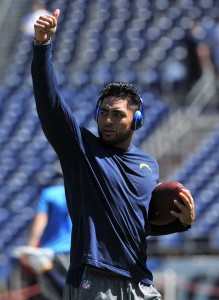
The Saints’ linebacking unit will also see some new faces, as both Manti Te’o and A.J. Klein are expected to earn starting jobs. Te’o won’t technically be a full-time player, however, as he’ll start in New Orleans’ base defense before coming off the field on passing downs, meaning he’ll likely play on roughly a third of the club’s defensive snaps. That’s probably a good strategy for Te’o given his health concerns — the former second-round pick has missed a whopping 30 of 64 possible games during his four-year career, mostly due to lower-body injuries. Klein, meanwhile, stays in the NFC South after beginning his career in Carolina, where he mostly served as a reserve and special teams ace behind one of the league’s best linebacker duos in Luke Kuechly and Thomas Davis. He figures to play alongside rookie Alex Anzalone in the Saints’ nickel defense.
Sterling Moore has been a valuable backup cornerback wherever he’s played, but he was stretched as a 12-game starter for the Saints last year. While he ranked as PFF’s No. 64 corner among 110 qualifiers, Moore finished 81st among 84 cornerbacks in Football Outsiders’ success rate. Moore played 76.7% of New Orleans’ defensive snaps (a career high) in 2016, but he will likely get pushed down the club’s depth chart during the upcoming season. The Saints invested a first-round draft choice in fellow corner Marshon Lattimore, while other defensive backs such as P.J. Williams are returning to health, meaning Moore will likely serve as a backup.
Moore was a cost-effective signing, but he wasn’t as cheap as the multitude of minimum salary benefit (MSB) contracts the Saints handed out this spring. As a reminder, MSB deals allow clubs to pay a player the veteran’s minimum based on their years of NFL experience while absorbing the cap charge for a player with only two accrued seasons. New Orleans signed 15 players to such pacts, six more than the next club (the Bears), and even guaranteed some portions of base salaries in those deals. For a team like the Saints that’s consistently up against the salary cap, it’s a smart strategy, as it allowed the team to bring in quality veterans such as Rafael Bush, Tony McDaniel, and Darryl Tapp without forfeiting much cap space.
Read more
Notable losses:
- Sam Barrington, LB
- Jairus Byrd, S: Released
- Justin Drescher, LS
- Kasim Edebali, LB
- Dannell Ellerbe, LB: Released
- Jahri Evans, G
- Roman Harper, S
- Tim Hightower, RB
- Tony Hills, T
- Paul Kruger, DE
- Luke McCown, QB: Released
- Jamarca Sanford, S
- Jason Trusnik, LB
- B.W. Webb, CB
- Kyle Wilson, CB
The Saints defense actually took a step forward in 2016! After running out arguably the league’s worst defense since the turn of the century in 2015, New Orleans improved last season, leaping up the defensive DVOA rankings all the way to…31st. Only the Lions posted worst results on the defensive side of the ball, as the Saints finished 14.6% below average against opposing offenses. As such, most of the club’s offseason was devoted to parting ways with aging dead weight on its defensive unit.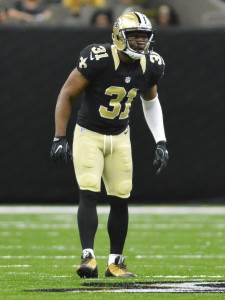
That effort started with the release of safety Jairus Byrd, who never lived up to six-year, $54MM contract he inked with the Saints prior to the 2014 campaign. While things had started looking up last season, with Byrd managing to appear in all 16 games and grading as the NFL’s No. 47 safety among 90 qualifiers (per PFF), the veteran defensive back had missed 15 contests in the two years prior. The Saints have gotten younger in the secondary over the past few seasons, using early-round draft picks on players such as Kenny Vaccaro, Vonn Bell, and Marcus Williams, leaving Byrd as the odd man out. Designated as a post-June 1 cut, Byrd’s $8MM in dead money will be spread across 2017 and 2018.
Byrd isn’t the only defensive back who won’t return to New Orleans next season, as fellow safety Roman Harper and cornerback B.W. Webb are also gone. Harper, who just wrapped up his second stint with the Saints, wasn’t sure as of June whether he wants to continue his NFL career at age-34, and he hasn’t been linked to any other clubs this offseason. Webb, meanwhile, has found a new contract (a one-year deal with the Bears) after appearing in 14 games for New Orleans in 2016. While starting a career-high seven contests, Webb played 56% of the Saints’ defensive snaps, although that was mostly a result of multiple injuries on the depth chart ahead of him.
Elsewhere on defense, veteran Paul Kruger was given the opportunity to play opposite Cameron Jordan in 2016, but didn’t do much with the chance — on 571 defensive snaps, Kruger posted only 1.5 sacks, 17 hurries, and nine hits against opposing quarterbacks. Now 31 years old and three years removed from a productive campaign, Kruger has yet to find a new NFL home. Linebacker Dannell Ellerbe, who like Kruger is also 31, was released just last week after recovering from a foot injury. Originally part of the return for Kenny Stills, Ellerbe never seemed to fit in with the Saints defense, and only appeared in 15 games over two years with the club.
Tim Hightower did mesh with New Orleans, albeit on the offensive side of the ball. After sitting out of the league for three years, Hightower played well for the Saints from 2015-16, averaging four yards per carry on 229 total rushes. The 31-year-old scored eight times on the ground during those two years, helped out in the receiving game, and ranked an impressive 10th among running backs in DVOA, meaning he was excellent on a per-play basis. Hightower is now Carlos Hyde‘s chief backup in San Francisco, while the Saints have moved on with Adrian Peterson and Alvin Kamara behind Mark Ingram.
Blocking for Hightower and the rest of the Saints’ running backs over the past two years was right guard Jahri Evans, who started an amazing 169 games for New Orleans dating back to 2006. Evans was cut in February of 2016, but ultimately made his way back to the Saints after a stop in Seattle. While Evans isn’t the All Pro lineman he was in the latter portion of the 2000s, he’s still an above-average guard: last year, Evans graded as the league’s No. 33 guard among 75 qualifiers, according to PFF. Now a Packer, Evans is a shoo-in for the Saints’ Ring of Honor when he hangs up his cleats, and could have a shot at enshrinement in the Pro Football Hall of Fame.
Trades:
- Acquired a 2017 first-round pick (No. 32) and a 2017 third-round pick (No. 103) from the Patriots in exchange for WR Brandin Cooks and 2017 fourth-round pick (No. 118).
- Acquired a 2017 third-round pick (No. 67; RB Alvin Kamara) from the 49ers in exchange for a 2017 seventh-round pick (No. 229; CB Adrian Colbert) and a 2018 second-round pick.
- Acquired LS Jon Dorenbos from the Eagles in exchange for a 2019 seventh-round pick.
Brandin Cooks is unquestionably a No. 1 NFL wideout — over the past two seasons, Cooks ranks fifth in receiving touchdowns, eighth in receiving yards, and 13th in receptions. Combine that with a contract that will pay roughly $10MM from 2017-18, and Cooks is an incredibly valuable asset. How valuable? The Patriots were willing to sacrifice a first-round pick to get him, and when New England’s acquisition of a fourth-rounder in the deal is factored out, the Pats rated Cooks as worth the 28th overall selection. While it’s still unclear why exactly the Saints dealt Cooks (off-field issues could’ve present, as Cooks complained about his target share last December), New Orleans ended up getting a left tackle (Ryan Ramczyk) and pass-rusher (Trey Hendrickson) out of the trade.
Draft picks:
After ranking 30th in DVOA and pass (and 23rd against opposing No. 1 wide receivers), the Saints must have been doing jumping jacks when Marshon Lattimore fell to them at pick No. 11. A run on quarterbacks and wideouts meant arguably the draft’s top cornerback prospect is now in New Orleans, and the Saints leapt at the chance to acquire him. Lattimore was excellent at Ohio State in 2016, as he allowed an opposing quarterback rating of only 31.9 while breaking up or intercepting 10 of his 41 targets, per Pro Football Focus. He became the Saints’ best corner the moment his name was called.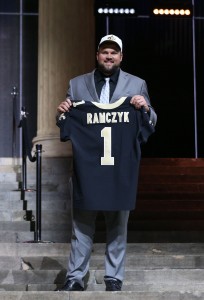
Armed with another first-round pick as a result of the Brandin Cooks trade, New Orleans picked up Wisconsin tackle Ryan Ramczyk with the final selection of Day 1. Initially slated to act as a reserve during his rookie campaign, Ramczyk is now the Saints’ starting left tackle following an injury to Terron Armstead. It’s entirely possible that Armstead will miss most or all of the season with a torn labrum, so Ramczyk will need to be capable from Day 1. A contributor in both the pass and run game, Ramczyk boasts an “urgent quickness in reach blocks” and “smooth pass slides with hands that are always punch ready,” according to Lance Zierlein of NFL.com.
While the Saints made the most of the majority of their draft choices (third-round linebacker Alex Anzalone is already projected as a starter), the club’s decision to trade up for Tennessee running back Alvin Kamara was a curious call. Kamara is certainly capable of putting impressive runs on film — check out his 50-yard touchdown run in New Orleans’ second preseason contest — but the Saints clearly overpaid to move up, as they sent 127 cents on the dollar to the 49ers for the No. 67 selection. As Bill Barnwell of ESPN.com noted earlier this year, New Orleans has made too many draft mistakes to be trading future capital for one specific (and unproven) player at a devalued position.
Extensions and restructures:
Other:
After signing a series of one-year contracts, defensive tackle Nick Fairley finally landed a multi-year deal, agreeing to a four-year, $28MM pact in order to return to New Orleans. But a heart condition means Fairley won’t play in 2017, might not play in the NFL again, and could lose a portion of his newly-signed deal. Clearly, Fairley’s health is the most important issue at play, but his absence is a large loss for the Saints, as he played nearly 70% of the club’s defensive snaps a year ago. New Orleans will hope last year’s first-round pick Sheldon Rankins grows in his second NFL campaign after missing seven games in 2016, but the team hasn’t done much to replace the production of Fairley.
Top 10 cap charges for 2017:
- Drew Brees, QB: $19,000,000
- Cameron Jordan, DE: $12,047,000
- Terron Armstead, T: $7,500,000
- Coby Fleener, TE: $7,500,000
- Max Unger, C: $7,400,000
- Zach Strief, T: $6,100,000
- Kenny Vaccaro, S: $5,676,000
- Mark Ingram, RB: $5,345,000
- Thomas Morstead, P: $4,700,000
- Larry Warford, G: $3,800,000
While former Rams head coach Jeff Fisher has earned derision for constantly finishing with a 7-9 record, Sean Payton hasn’t done much better in recent years, as the Saints have posted three consecutive nine-loss campaigns. Sure, Payton has a Super Bowl title in his back pocket and a lifetime winning percentage of .588, but that NFL is a “What Have You Done For Me Lately?” league. With Drew Brees entering the final year of his contract, and the Saints defense consistently holding back the reset of the club, it’s entirely possible New Orleans submits to a rebuild if 2017 doesn’t go as planned.
Information from Over the Cap and Roster Resource was used in the creation of this post. Photos courtesy of USA Today Sports Images.
By Dallas Robinson |
at August 25, 2017 2:22 pm
The Dolphins were 1-4 last October 9 and looked poised to miss the playoffs for the eighth consecutive season in what would have been a disappointing first go-round for new head coach Adam Gase. Miami rebounded, however, reeling off six straight victories, winning nine of its final 11 games, and finishing with a 10-6 record and a Wild Card berth. Starting quarterback Ryan Tannehill missed the Dolphins’ final three regular season games and their postseason contest with a knee injury, a precursor to another health issue that would cause Miami to re-calibrate in the first week of August 2017.
Notable signings:
- Kenny Stills, WR: Four years, $32MM. $16.95MM guaranteed.
- Andre Branch, DE: Three years, $24MM. $16.8MM guaranteed.
- Lawrence Timmons, DE: Two years, $12MM. $11MM guaranteed.
- Jay Cutler, QB: One year, $10MM. $5MM guaranteed. $3MM available via incentives.
- Nate Allen, S: One year, $3.4MM. Fully guaranteed.
- Jermon Bushrod, G: One year, $3MM. $2.25MM guaranteed.
- Ted Larsen, OL: Three years, $5.65MM. $1.75MM guaranteed.
- Anthony Fasano, TE: One year, $2.75MM. $1.25MM guaranteed.
- Rey Maualuga, LB: One year, minimum salary benefit. $80K guaranteed.
- Alterraun Verner, CB: One year, minimum salary benefit. $80K guaranteed.
- John Denney, LS: One year, minimum salary benefit. $40K guaranteed.
- Damien Williams, RB: One year, $1.797MM. Signed original round RFA tender.
- T.J. McDonald, S: One year, $1.344MM.
- David Fales, QB: One year, $690K.
If you took a long weekend near the beginning of August, you may have missed the entire Jay Cutler-to-Miami saga — it happened that quickly. On August 3, Ryan Tannehill, who had missed the end of the 2016 campaign with an ACL/MCL sprain, went down during Dolphins practice, leading the club’s decision-makers to “fear the worst” in regards to their starting quarterback’s health. Just four days later, Cutler was back in the NFL, having un-retired and left his gig as a FOX analyst in order to sign a one-year deal with Miami.
Cutler, of course, was completely ineffective a year ago, posting one of the worst seasons of his career. But just one year prior, working under then Bears offensive coordinator Adam Gase, Cutler produced an excellent campaign that included the best quarterback rating and second-best completion percentage of his NFL tenure. In fact, Cutler’s 2015 numbers were remarkably similar to those of Tannehill in 2016. The following table contrasts Cutler and Tannehill’s statistics under Gase in 2015 and 2016, respectively, and the figures are indexed (courtesy of Pro Football Reference), meaning 100 is league average and a higher number is better:

Tannehill was a bit better in 2016 than Cutler was in 2015, but if Cutler can come close to matching Tannehill’s performance from last season, and keep Miami in the top half of the offensive DVOA rankings, the Dolphins would likely be content. If Cutler does reach that level, Miami would be facing several questions next offseason, especially if they have interest in retaining Cutler beyond 2016. The Dolphins, for what’s it worth, can release Tannehill next offseason in a move that would save $15.2MM against the cap (and incur only $4.6MM in dead money). Whether that’s a viable scenario depends entirely on Cutler’s showing, and whether Tannehill can pass a physical next spring.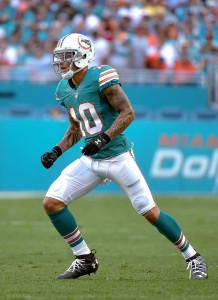
Cutler will be throwing the ball to an impressive group of wide receivers that includes Jarvis Landry, DeVante Parker, and Kenny Stills, the latter of whom re-signed with the Dolphins on a four-year pact. Stills, 25, posted a career-high nine touchdowns last season, and eight of those scores came on receptions of 20+ yards, tying him with Antonio Brown for the most deep scores among pass-catchers. Although pre-free agency rumors indicated Stills could garner upwards of $12MM annually on the open market, Miami inked Stills for only $8MM per season, an annual salary that ranks just 21st among wideouts.
In order for Stills to get deep, the Dolphins’ offensive line will need to hold up better than it did last season, when the unit ranked 21st in adjusted sack rate. Miami believed it could rectify its guard situation on the cheap, and the club didn’t spent much money to upgrade its interior. Jermon Bushrod is back at right guard after finishing 26th in snaps per blown block a year ago, per the 2017 Football Outsiders Almanac, while free agent addition Ted Larsen won’t contribute in 2016 after tearing his biceps, meaning the inexperienced Jesse Davis is now projected to start at left guard. Tight end Anthony Fasano, now in his second stint in South Beach, should be able to help on the edge, as he graded as the league’s No. 1 blocking tight end in 2016, according to Pro Football Focus.
On the defensive side of the ball, the Dolphins made a number of curious signings, and that list starts with defensive end Andre Branch. Let’s go back to 2016, when Miami originally signed Branch: he was coming off a season with the Jaguars in which he saw 597 defensive snaps and managed four sacks and 18 hurries. The Dolphins inked Branch to a one-year pact worth only $3MM. In his first season with Miami, Branch improved to 5.5 sacks and 20 hurries, but had to play nearly 200 more snaps to get there. Keeping in mind that he’s now one year older, does the Dolphins’ evaluation of Branch as a $8MM per year player make any sense? Just 12 months after finding a value on the free agent scrap heap, Miami over corrected and made Branch a top-20 edge rusher in terms of annual salary.
Football operations chief Mike Tannenbaum and general manager Chris Grier‘s indefensible decisions continued at the second level, as the signing of former Steelers linebacker Lawrence Timmons was a clear overpay. The 31-year-old Timmons wasn’t linked to any other clubs besides the Dolphins in free agency, so it’s possible Miami was negotiating against itself as it agreed to a two-year deal that includes $11MM guaranteed. Timmons can’t cover anymore, and while some of his pass defense struggles may have been a product of Pittsburgh’s scheme, the Dolphins are going to be disappointed if Timmons is asked to play in nickel packages. Fellow Miami addition Rey Maualuga finished only 11 spots worse than Timmons in PFF’s linebacker rankings, and he signed a minimum salary benefit contract, further exposing the mistake that is Timmons’ deal.
The Dolphins went bargain-hunting in the secondary, signing low-cost free agents such as Nate Allen, T.J. McDonald, and Alterraun Verner. Allen, who served as the Raiders’ third safety last season, figures to start for Miami for the first half of the 2017 campaign as McDonald serves an eight-game suspension. The Dolphins knew McDonald was banned before they signed him, and perhaps saw an opportunity to land a 26-year-old safety with 53 starts under his belt on a cheap deal. Verner, meanwhile, didn’t find a deal until July, but he could play a larger role than expected now that Tony Lippett is lost for the year with a torn Achilles.
Read more
Notable losses:
- Isa Abdul-Quddus, S: Released
- Donald Butler, LB
- Jordan Cameron, TE: Retired
- Chimdi Chekwa, CB
- Jelani Jenkins, LB
- Dominique Jones, TE
- Dion Jordan: Waived
- Earl Mitchell, DT: Released
- Spencer Paysinger, LB
- Bacarri Rambo, S
- Dion Sims, TE
- Mario Williams, DE: Released
- T.J. Yates, QB
Despite boasting excellent players like Ndamukong Suh and Cameron Wake, the Dolphins’ defensive line was still a weakness last season, finishing 18th in adjusted line yards and 31st in adjusted sack rate. With an eye towards improving that ranking, Miami began releasing dead weight this spring, cutting ties with Earl Mitchell, Mario Williams, and Dion Jordan. The releases of Williams and Jordan are understandable: Williams was overpaid during his one season with the Dolphins and didn’t offer much at defensive end, while Jordan is one of the larger draft busts in recent memory. Letting Mitchell go is a bit more peculiar, however, especially given that Miami is now on the hunt for a defensive tackle that does exactly what Mitchell did — stop the run. Mitchell didn’t offer any pass rush, but the Dolphins have Suh for that, so cutting a serviceable veteran and creating a new area of need wasn’t the wisest route.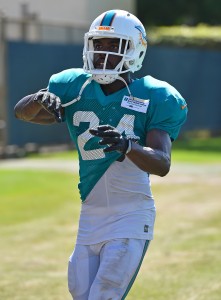
Miami didn’t particularly have a decision to make on safety Isa Abdul-Quddus, as the 2016 free agent addition suffered a serious neck injury near the tail end of last season. IAQ, who was excellent in his first season with the Dolphins, is potentially facing the end of his career, as neck issues aren’t to be trifled with — as of March, Miami wasn’t sure whether Abdul-Quddus would be able to resume football activities. Bacarri Rambo, who played roughly 40% of the Dolphins’ snaps while filling in for Reshad Jones, is also gone, meaning Miami will be without the two safeties who saw the most playing time for the club last year.
On offense, the Dolphins witnessed the loss of two tight ends, Dion Sims and Jordan Cameron. Sims landed one of the more surprising contracts of the free agent period, as he inked a three-year, $18MM pact with the Bears that contains $6MM in guarantees. Sims, 26, has never topped 30 receptions or 300 yards receiving during his four-year career, but the Dolphins reportedly wanted to retain him ever after acquiring Julius Thomas from the Jaguars. Cameron, meanwhile, announced his retirement after suffering four concussions in four seasons. He managed only three appearances and eight receptions in 2016.
Trades:
- Acquired a 2018 seventh-round pick from the Jaguars in exchange for T Branden Albert (pick returned to Jacksonville due to Albert’s retirement).
- Acquired TE Julius Thomas from the Jaguars in exchange for a 2017 seventh-round pick (No. 240).
- Acquired DE William Hayes and a 2017 seventh-round pick (No. 223) from the Rams in exchange for a 2017 sixth-round pick (No. 206).
- Acquired a 2017 fifth-round pick (No. 164; OL Isaac Asiata) and a 2017 sixth-round pick (No. 194; DT Vincent Taylor) from the Eagles in exchange for a 2017 fifth-round pick (No. 166; WR Shelton Gibson) and a 2017 fifth-round pick (No. 184; S Nathan Gerry).
- Acquired a 2017 seventh-round pick (No. 237; WR Isaiah Ford) and a 2018 seventh-round pick from the Buccaneers in exchange for a 2017 seventh-round pick (No. 223; DT Steve Tu’ikolovatu).
Jay Cutler isn’t the only player with a history of success under Adam Gase whom the Dolphins acquired this offseason. Tight end Julius Thomas is heading to Miami, as well, after the Dolphins agreed to send a late-round selection to Jacksonville (some initial reports indicated Thomas would be swapped for tackle Branden Albert, but the Dolphins and Jaguars ended up making separate deals involving those players).
Thomas, 29, hasn’t done anything to live up to the five-year, $46MM contract he signed with Jacksonville prior to the 2015 campaign, as he averaged only 38 receptions and 268 yards through two years with the Jags. He posted superb numbers with Gase in Denver, however, including back-to-back seasons with 12 touchdown receptions. Those high-scoring years came in a Peyton Manning-led offense, but there’s some hope that Thomas can come closer to his Denver level of production than his Jacksonville statistics. Manning, for what’s worth, had a hand Miami’s acquisition of Thomas, as he spoke with Dolphins offensive coordinator Clyde Christensen before the Fins made the move.
While Thomas was Miami’s most notable trade addition, the club also acquired William Hayes at essentially no cost, moving down only 17 spots in the draft in order to bring in the veteran defensive end. That the Dolphins were able to pick up Hayes for such a small price is still rather astonishing, as the 32-year-old is a more-than-viable rotational lineman after grading as the NFL’s No. 17 edge defender on 514 snaps last season, per PFF. Since 2012, Hayes has managed at least 24 quarterback pressures in every season, and has missed only four total games during that span.
Draft picks:
Defensive end was considered a priority for the Dolphins as far back as February, so it wasn’t stunning when the club selected Missouri edge rusher Charles Harris with the 22nd overall pick. Harris — who “explodes out of his stance,” per Lance Zierlein of NFL.com — managed nine sacks a season ago, and also posted a sack, hit, or hurry once every six pass-rushing attempts in 2016, per PFF. The only problem? There’s no place for Harris to play at the moment after the Dolphins extended Cameron Wake, re-signed Andre Branch, and acquired William Hayes. Harris will see rotational work, to be sure, but he won’t be a Day 1 starter in South Beach.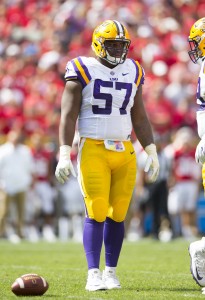
The same isn’t true for fifth-round pick Davon Godchaux, though, as the LSU product is expected to work as a starter at defensive tackle. It’s a surprising turnaround for Godchaux, as the Dolphins didn’t believe he nor fellow rookie Vincent Taylor were capable of serving even as rotation players as recently as late June. Although he’s a bit slow off the snap, Godchaux has the strength necessary to play against the run game, according to Matt Miller of Bleacher Report, who compared Godchaux to pro defenders Glenn Dorsey and Ego Ferguson.
The rest of Miami’s rookie class probably won’t see all that much action during the upcoming season. Raekwon McMillan had been poised to serve as a starting linebacker for the Dolphins, but he’s lost for the season after suffering a torn ACL. Cornerback Cordrea Tankersley has been called “stiff” by some in the Miami organization, and he’s not expected to play a large role even following the season-ending injury to fellow defensive back Tony Lippett. Similarly, Ted Larsen‘s torn biceps won’t affect the status of first-year guard Isaac Asiata, who is still working with Miami’s second team.
Extensions and restructures:
While we’ve already discussed the Dolphins’ strange decisions in free agency (Andre Branch, Lawrence Timmons), the club also made some bizarre calls with regards to extensions. Reshad Jones is Exhibit A: while he’s been one of the league’s best (and most underrated) safeties in recent seasons, Jones is now nearing age-30 and coming off a campaign in which he missed 10 games with a torn rotator cuff. Faced with that information, most teams likely would have let Jones play out the final year of his contract in 2017 before looking into an extension. Miami, on the other hand, made Jones the NFL’s third-highest-paid safety on an annual basis and handed him nearly $20MM in full guarantees on a deal that Jason Fitzgerald of Over the Cap calls one of the worst in the AFC East.
Linebacker Kiko Alonso‘s extension was another strange ordeal, especially given that he was a restricted free agent this spring. Miami’s first mistake was tendering Alonso at the first-round level at a cost of nearly $4MM — the second-round tender would have been more than sufficient, as no opposing club was going to cough up a Day 2 selection for the right to sign Alonso. The Dolphins then compounded that error, extending Alonso on a four-year deal that — given Miami’s team control over Alonso in 2017 — essentially valued the former Oregon Duck as an $8.3MM player, right around the range of a Dont’a Hightower. Alonso was serviceable during his first year with the Dolphins, but his lack of availability is concerning, as he played only 472 snaps from 2014-15.
Other:
Top 10 cap charges for 2017:
- Ryan Tannehill, QB: $20,300,000
- Ndamukong Suh, DT: $19,100,000
- Jay Cutler, QB: $10,000,000
- Mike Pouncey, C: $8,975,000
- Byron Maxwell, CB: $8,500,000
- Cameron Wake, DE: $7,500,000
- Julius Thomas, TE: $5,600,000
- Andre Branch, DE: $5,000,000
- William Hayes, DE: $4,750,000
- Lawrence Timmons, LB: $3,775,000
No one expected Jay Cutler to be leading the Dolphins in 2017, but if he, running back Jay Ajayi, and a cavalcade of offensive weapons can keep Miami on schedule, the club could be in contention for another Wild Card berth (an AFC East crown looks completely untenable due to the presence of the Patriots). It’s Miami’s defense that may prove critical next season, as the unit and new coordinator Matt Burke needs to improve on its No. 19 DVOA ranking in order for the Dolphins to take a leap. If it does, the playoffs aren’t a unreasonable goal in South Beach.
Information from Over the Cap and Roster Resource was used in the creation of this post. Photos courtesy of USA Today Sports Images.
By Dallas Robinson |
at August 23, 2017 3:40 pm
The Chargers are everyone’s favorite 2017 sleeper. The Bolts are moving to a new city, coming off of two consecutive double-digit loss seasons, and have earned only one postseason berth in the past seven years, but Los Angeles looks poised to at least contend for the AFC West during the upcoming campaign. Here’s what general manager Tom Telesco & Co. did this offseason:
Notable signings:
- Melvin Ingram, DE: Four years, $54MM. $34MM guaranteed. $2MM available via incentives. Had been assigned franchise tag.
- Russell Okung, T: Four years, $53MM. $25MM guaranteed.
- Jahleel Addae, S: Four years, $22.5MM. $8MM guaranteed.
- Damion Square, DL: Two years, $4MM. $1.225MM guaranteed.
- Mike Windt, LS: Four years, $4.421MM. $620K guaranteed.
- Tre Boston, S: One year, $900K. $100K guaranteed.
- Kellen Clemens, QB: One year, minimum salary benefit. $80K guaranteed.
- Kenny Wiggins, OL: One year, $865K. $75K guaranteed.
- Kenjon Barner, RB: One year, $815K. $75K guaranteed.
- Branden Oliver, RB: One year, $800K. $50K guaranteed.
- Dontrelle Inman, WR: One year, $2.746MM. Signed second-round RFA tender.
- Jeff Cumberland, TE: One year, $775K.
- Tenny Palepoi, DL: One year, $615K.
The Chargers’ offensive line has been a clear weakness for the past few seasons, and that was never more apparent than in 2016. With ineffectiveness plaguing the club’s guard positions, Los Angeles ranked in the bottom third of the NFL in adjusted sack rate, adjusted line yards, and pressure rate. Left tackle was a problem, as well, as King Dunlap graded as a below-average blindside protector in his second straight injury-shortened campaign. With an eye towards improving Philip Rivers‘ protection, the Chargers struck quickly to sign tackle Russell Okung on the first day of free agency.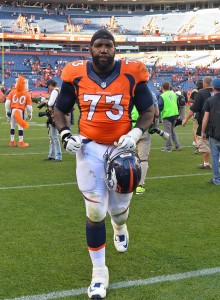
Okung spent the 2016 season with the division rival Broncos after inking an oft-criticized, self-negotiated contract that contained no guaranteed money. Although Okung ended up earning $8MM last year, Denver declined a multi-season option on the veteran offensive lineman that would have locked him in with the Broncos through 2020. Okung ultimately came out on top, however, as his new Chargers deal makes him the league’s highest-paid tackle on an annual basis, slightly ahead of Washington’s Trent Williams.
Clearly, the pact is an overpay, as Okung only offered middling production last season (No. 38 among offensive tackle among 78 qualifiers, per Pro Football Focus). And if the Chargers are looking for reliability, they aren’t getting it with Okung, who’s missed 24 games during his seven-year career. But for a club that’s been looking for any kind of consistent effort along the offensive line, Okung should be able to stabilize the left tackle position for the next several seasons.
Okung wasn’t the Chargers’ most significant investment of the offseason, however — that moniker goes to edge rusher Melvin Ingram, who was initially assigned the franchise tag before agreeing to a four-year extension. Ingram, 28, dealt with injury issues earlier in his career, but he’s appeared in all 16 games in each of the past two seasons. During that time, Ingram ranks fourth among 3-4 outside linebackers with 125 total pressures, and also registered 18.5 sacks.
In new defensive coordinator Gus Bradley‘s 4-3 scheme, Ingram will move to defensive end, meaning he should have even more chances to get after opposing quarterbacks. The change shouldn’t be all that extreme, however, as head coach Anthony Lynn says Los Angeles played “four-down spacing” in 2016 even though it used a 3-4 front. Lining up opposite reigning Defensive Rookie of the Year Joey Bosa, Ingram should be able to help the Chargers improve upon their 15th ranked adjusted sack rate.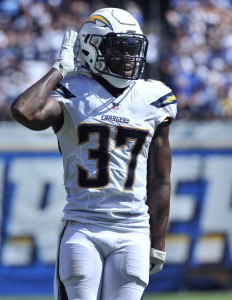
In the second level of their defense, the Chargers re-signed Jahleel Addae to a four-year pact and also brought in fellow safety Tre Boston, inking the latter after he was cut by the Panthers. Addae is quietly one of the more effective safeties in the NFL: in 2016, he graded 13th overall at his position, per PFF, although he missed half the season after suffering a broken collarbone in Week 2. Among all defensive backs, Addae ranked 32nd in PFF’s tackle per opportunity, and is effective against both the run and pass. Boston, meanwhile, is still only 25 years old and is competing with incumbent Dwight Lowery for a starting job.
Like Lowery, offensive lineman Kenny Wiggins is fighting for a starting role, although Wiggins may have a near-lock on the No. 1 slot at right guard. Wiggins, a 29-year-old journeyman who was nearly out of the league as recently as 2013, is now slated to play a major role along Los Angeles’ offensive line following second-round rookie Forrest Lamp‘s season-ending injury. Lamp wasn’t the only offensive lineman on which the Chargers used a relatively early pick, as third-rounder Dan Feeney is also in contention for the right guard job.
Melvin Gordon will Los Angeles’ primary back running behind Wiggins and the rest of the Chargers’ offensive line, and his workload doesn’t figure to be reduced after he played 659 offensive snaps a year ago (sixth among NFL running backs). The Chargers signed Branden Oliver and Kenjon Barner to cheap single-season pacts, and Kenneth Farrow is returning, but Gordon could see an increase on his 254 rushing attempts. It won’t be surprising if Los Angeles seeks to acquire another — preferably pass-catching — running back during roster cuts, with Travaris Cadet, Andre Ellington, and Jamaal Charles among the candidates for release next week.
Read more
Notable losses:
- Jeremy Butler, WR
- King Dunlap, T: Released, then retired
- Brandon Flowers, CB: Released, then retired
- D.J. Fluker, G: Released
- Orlando Franklin, G: Released
- Javontee Herndon, WR
- Ronnie Hillman, RB
- Stevie Johnson, WR: Released
- Sean Lissemore, DT
- Robert McClain, CB
- Dexter McCluster, RB
- Darrell Stuckey, S: Released
- Manti Te’o, LB
- Tourek Williams, LB
- Danny Woodhead, RB
Los Angeles began the offseason by purging its offensive line, releasing King Dunlap and D.J. Fluker in March before cutting ties with Orlando Franklin in May. All three members of that group played on at least 70% of the Chargers’ offensive snaps in 2016, but none was overly effective: none of Dunlap, Fluker, nor Franklin graded as a top-30 player at his respective position, according to PFF. Each was also scheduled to be relatively expensive in 2017, as all three carried cap charges in excess of $6MM for the upcoming season. Fluker, a former first-round selection, has since signed on with the Giants, while Franklin spent less than a week with New Orleans before being cut again.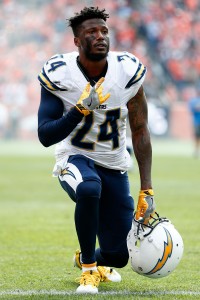
Dunlap, meanwhile, ended up hanging up his cleats after drawing interest from only known club (the Broncos), and cornerback Brandon Flowers did the same, announcing his retirement five months after being released by the Chargers. Like Dunlap, Flowers received a few inquiries on the free agent market, as clubs like the Steelers, Cardinals, and Patriots all put in calls. But Dunlap and Flowers could be an indication that general manager Tom Telesco is relying on veteran players too often, and not cutting dead weight early enough, as the rest of the NFL decided Dunlap and Flowers weren’t worth signing.
Manti Te’o did land a new contract, but Los Angeles made the correct call in not matching the veteran linebacker’s two-year offer from the Saints. One of the best collegiate linebackers of the past decade, Te’o simply hasn’t been able to stay healthy at the professional level. It’s most been lower-body injuries that have sidelined Te’o, and that was true once again in 2016, as a torn Achilles ended his season after just three games. All told, Te’o missed a whopping 30 contests during his four-year run with the Chargers.
A few of Los Angeles’ offensive defections also dealt with health issues in 2016: a torn ACL forced running back Danny Woodhead to miss the majority of the season for the second time in three years, while wideout Stevie Johnson was sidelined for the entirety of the campaign following meniscus surgery. While the Chargers now have the wide receiver depth to withstand the loss of Johnson, it’s fair to argue the club should have made an effort to retain Woodhead. Although he’s now 32 years old, Woodhead was incredibly effective during his two healthy years with the Chargers, averaging 97 receptions in 2013 and 2015. Los Angeles doesn’t have another weapon like Woodhead on its current roster.
Trades:
- Acquired QB Cardale Jones from the Bills in exchange for a conditional seventh-round pick in 2018 or 2019.
While the Chargers were open to drafting a quarterback in the 2017 draft, they ultimately made seven selections without picking a signal-caller. Instead, Los Angeles sent a conditional late-round choice to the Bills for Cardale Jones, who was selected in the fourth round in 2016. Jones, 24, managed only 11 attempts last season, and the most notable thing he did during his rookie campaign was knock a phone out of a reporter’s hand during training camp with a pass that was overthrown by 20 yards.
Nearly every scouting report on Jones was similar: the Ohio State product has excellent size and arm strength, but doesn’t have a sound ability to read defenses or manage the pocket. Whether Anthony Lynn and Ken Whisenhunt can harness Jones’ talent is anyone’s guess, but he’s not expected to serve as Philip Rivers‘ backup in 2017. That honor will instead go to veteran Kellen Clemens, who’s served as Rivers’ No. 2 for the past three years.
Draft picks:
The Chargers simply can’t catch a break with their early-round selections: seventh overall pick Mike Williams isn’t expected to see the field until at least October as he recovers from a back injury, while second-rounder Forrest Lamp is done for the season after tearing his ACL. While Los Angeles clearly couldn’t predict Williams would suffer a herniated disc on the first day of training camp, the wisdom of the club using a top-10 pick on a wide receiver can be questioned, as the Chargers already employ Keenan Allen, Tyrell Williams, Travis Benjamin, and Dontrelle Inman, and had far greater needs elsewhere on the roster.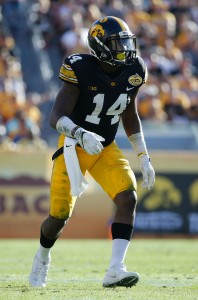
A number of mock drafts (including our own) projected Los Angeles to use that seventh pick on safety Malik Hooker, pegging the Ohio State product as defensive coordinator Gus Bradley‘s version of Earl Thomas. Instead, the Chargers opted to wait until Day 3 to address their secondary, using fourth- and fifth-round selections on defensive backs Rayshawn Jenkins and Desmond King, respectively.
King is especially intriguing, as Steve Palazzolo of Pro Football Focus labeled the former Iowa Hawkeye the No. 1 mid-round gem of the draft. While he doesn’t offer speed, King can play either safety or corner (the latter probably only in a zone-based scheme), and has excellent ball skills, as he broke up 20 passes over the past two seasons. He’s also a sure tackler, per Palazzolo, who noted King missed only 11 tackles on 176 attempts from 2014-16.
Other:
Owner Dean Spanos had the option to move the Chargers to Los Angeles in time for the 2017 season, but decided to hold off for one more year in order to give San Diego the chance to retain the team. The city (and county) failed, however, falling $175MM short of what a Qualcomm Stadium replacement would have cost. Instead, the Chargers will play in LA’s StubHub Center for the next three seasons before moving to Inglewood, where they’ll share a stadium with the Rams.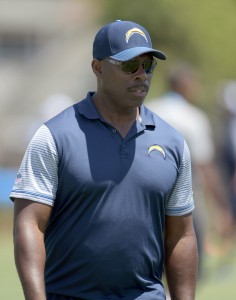
The Chargers are only moving ~100 miles north, but relocating is never a simple task (as anyone who’s watched Amazon’s All or Nothing Rams documentary has witnessed). Doing so with a rookie head coach is even more difficult, as Anthony Lynn will attempt to manage the club’s move while also overseeing the Chargers’ roster for the first time. Lynn, who was linked to every head coaching vacancy this offseason, helped diagram one of the league’s more innovative running games with the Bills in recent seasons, and though Los Angeles retained incumbent offensive coordinator Ken Whisenhunt, Lynn will surely seek to improve a rushing offense that ranked 24th in DVOA in 2016.
New defensive coordinator Gus Bradley will have an excellent cornerback on his hands for at least two more years, as the Chargers made the easy decision to exercise Jason Verrett‘s 2018 option. Verrett, 26, has been excellent when he’s been able to stay on the field, as he boasted the NFL’s best coverage grade in 2015 (per PFF) and has allowed a career catch rate of just 57%. Health hasn’t been given for Verrett, however, as he’s missed 24 games through three seasons.
Top 10 cap charges for 2017:
- Philip Rivers, QB: $20,000,000
- Melvin Ingram, DE: $14,875,000
- Corey Liuget, DT: $9,500,000
- Keenan Allen, WR: $8,650,000
- Travis Benjamin, WR: $6,500,000
- Russell Okung, T: $6,000,000
- Joey Bosa, DE: $5,880,380
- Joe Barksdale, T: $5,546,875
- Antonio Gates, TE: $5,437,500
- Orlando Franklin, G: $5,100,000 (dead money)
A new city. A new head coach. A new defensive scheme. In a division that boasted two postseason teams in 2016, the Chargers may have a difficult time earning a playoff berth. But Los Angeles has depth all along its roster and top-end talent at crucial positions such as wide receiver and cornerback, so contending for the AFC West crown — or at the least, a wild card slot — is certainly within reach.
Information from Over the Cap and Roster Resource was used in the creation of this post. Photos courtesy of USA Today Sports Images.
By Dallas Robinson |
at August 21, 2017 8:24 pm
Although the 2016 Jaguars may not have been as poor as their 3-13 record indicated (Football Outsiders pegged Jacksonville’s expected wins at 5.4 while Pro Football Reference had them at 5.9), the club still posted at least 11 losses for the sixth consecutive season. Having fired their head coach in-season, the Jaguars seemed likely to add free agent talent to their roster, and with nearly $70MM in available cap space, they had the funds to do so.
Notable signings:
- Calais Campbell, DL: Four years, $60MM. $30MM guaranteed.
- A.J. Bouye, CB: Five years, $67.5MM. $26MM guaranteed.
- Barry Church, S: Four years, $26MM. $12MM guaranteed.
- Abry Jones, DT: Four years, $15.5MM. $3.5MM guaranteed.
- Earl Watford, OL: Two years, $5MM. $1MM guaranteed.
- Mychal Rivera, TE: Two years, $3.25MM. $750K guaranteed.
- Lerentee McCray, LB: One year, $2MM. $750K guaranteed.
- Stefan Charles, DT: Two years, $4MM. $400K guaranteed.
- Audie Cole, LB: Two years, $2.6MM. $100K guaranteed.
- Patrick Omameh, G: One year, $875K. $100K guaranteed.
- Brian Dixon, CB: One year, $690K.
- Andrew Gachkar, LB: One year, minimum salary benefit.
- Jonathan Grimes, RB: One year, minimum salary benefit.
- DuJuan Harris, RB: One year, minimum salary benefit.
- Jeron Johnson, S: One year, minimum salary benefit.
- Malliciah Goodman, DE: Contract terms unknown.
The Jaguars have completely revamped their starting defensive backfield over the past two years, first adding Jalen Ramsey and Tashaun Gipson through the draft and free agency, respectively, in 2016 before signing A.J. Bouye and Barry Church this spring. Bouye, particularly, was one of the more interesting free agent cases in recent memory, as he’d only played on 819 defensive snaps over his first three NFL seasons before seeing action on 722 plays last year. He was excellent, as well, grading as the league’s No. 2 cornerback, per Pro Football Focus, and ranked as PFR’s No. 1 free agent when the market opened.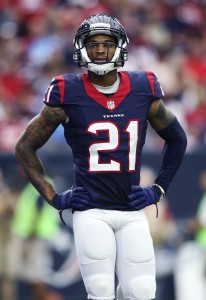
Due to his productivity and his age (he just turned 26 last week), Bouye generated a great deal of interest, as the Colts, Titans, Bears, Buccaneers, Jets, Eagles, and Texans all inquired on the free agent corner. Jacksonville, though, has never been afraid to open up its checkbook for top-of-the-market deals, and made Bouye the eighth-highest-paid cornerback in terms of annual salary — he ranks fourth in guarantees at $26MM. Now paired with Ramsey, who lived up to his fourth overall draft status during his rookie campaign, Bouye gives the Jaguars one of the league’s best secondaries.
Church will join Ramsey and Bouye in the back-end of Jacksonville’s defense, and while he’s not an elite athlete on the level of the Jaguars’ starting corners, Church is a sound, reliable safety who should provide capable play for the duration of his four-year contract. Since becoming a starter in 2013, the 29-year-old Church has started 59 of a possible 64 games, and while he missed four contests in 2016, that was due to a freak injury (broken arm) and not a nagging ailment. Jacksonville not only now boasts an an outstanding defensive backfield, but faces the third-easiest schedule of opposing offenses, according to Warren Sharp‘s 2017 NFL Preview.
The Jaguars didn’t stop adding to their defense after upgrading the secondary, as the club also targeted reinforcements along the front four. Calais Campbell was the best interior defensive lineman available during the free agent period, and Jacksonville convinced him to move to northern Florida instead of Denver (Campbell reportedly narrowed his choice to the Jaguars and Broncos). While Campbell is an extremely talented player against both the run and pass, it’s fair to question the wisdom of signing a near-31-year-old to a four-year pact that contains $30MM in guaranteed money. The deal contains a signing bonus of just $6MM, so Jacksonville can exit the contract after two years, but it’s certainly a risky proposition. In 2017, expect Campbell to play end on early downs before sliding inside on passing plays.
Campbell is a new addition to the Jaguars’ defensive line, while Abry Jones will be returning to Jacksonville for a fifth consecutive season. Jones, who at age-25 is five years younger than Campbell, re-signed with the Jags in February, well before free agency actually opened. I can’t help but wonder if he could’ve landed a larger contract by waiting and meeting with other teams, and Jacksonville may have orchestrated a steal. Jones is an exceptional run defender and played on nearly half the Jaguars’ defensive snaps a year ago, but his contract is essentially equal to that of the Jets’ Steve McLendon, who is a vastly inferior player.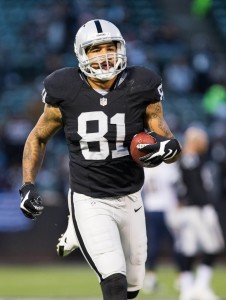
While the Jaguars didn’t spend extravagantly on the offensive side of the ball, a couple of veterans could end up playing relatively impactful roles. Tight end Mychal Rivera once posted 58 receptions for the Raiders, but consistently saw his role dwindle over the past two years. While Jacksonville ran of ton of three wide receiver formations last season (75% of plays, 15% above league average), that percentage could fall in the early weeks of the season as Marqise Lee recovers from a high ankle sprain. Without an established No. 3 wideout, it’s possible the Jaguars could use more two tight end sets, potentially giving Rivera an opportunity to make an impression.
Patrick Omameh may also see his responsibilities enhanced, as Branden Albert‘s release means rookie Cam Robinson will now start at left tackle, leaving a vacancy at left guard that Omameh figures to fill. Omameh, who received a guarantee of just $100K, will be the weak link on Jacksonville’s offense line, but he’s not a disaster, as PFF ranked him as the No. 31 guard in the NFL last season. However, PFF gave Omameh poor run-blocking marks, and given the Jaguars’ intention to lean on the running game in 2017, the club may need to search for other options on the left side. Austin Pasztor, who just signed with the Falcons last week, would have been an intriguing signing.
Read more
Notable losses:
- Branden Albert, T: Released
- Tyson Alualu, DT
- Prince Amukamara, CB
- Kelvin Beachum, T
- Jonathan Cyprien, S
- Jordan Hill, DT
- Davon House, CB: Released
- Luke Joeckel, T
- Sen’Derrick Marks, DT: Released
- Roy Miller, DT: Released
- Jared Odrick, DT: Released
- Denard Robinson, RB
- Dan Skuta, LB: Released
- Bryan Walters, WR: Released
Looking at list of notable Jacksonville losses, it’s apparent the Jaguars were intent on overhauling three key areas of their roster: the offensive line, the defensive line, and the secondary. Along the front five, Jacksonville struck quickly to acquire offensive tackle Branden Albert from the Dolphins, sending a late-round 2018 pick to Miami in exchange for the veteran blindside protector. While the Jaguars thought they had stabilized the left side of their offensive line, Albert’s addition was anything but solidifying.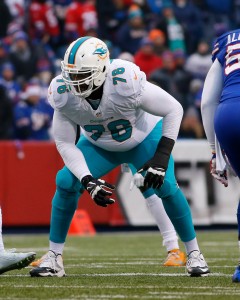
Albert held out for a new deal in April, but eventually reported to camp after the Jaguars indicated they wouldn’t rework his deal. At the end of July, Albert abruptly announced his retirement, leaving Jacksonville in a precarious position. Just a week later, Albert un-retired and attempted to again report to Jacksonville, but general manager David Caldwell & Co. weren’t having it. Having grown tired of Albert’s act, the Jaguars first placed Albert on the reserve/retired list, and then simply released him. While there’s an argument to be made that Jacksonville should have held onto Albert’s contractual rights, the club was likely ready to part ways with Albert given his offseason antics.
Albert won’t be part of the Jaguars’ offensive line in 2017, and neither will Kelvin Beachum nor Luke Joeckel, each of whom were allowed to depart via free agency. Jacksonville took a risk on Beachum last season, offering him a unique option-based contract as he recovered from a torn ACL. Although he stayed healthy, Beachum wasn’t effective as the Jaguars’ left tackle, and has never rebounded to his pre-injury level of play. Joeckel, meanwhile, was a massive disappointment after being drafted second overall in 2013, and had been moved to guard by the end of his Jacksonville tenure. The Seahawks, shockingly, saw fit to sign Joeckel a one-year deal worth $8MM, a price the Jags were never going match.
Jacksonville’s defensive line will see even more change than the team’s offensive line, as none of Sen’Derrick Marks, Roy Miller, Jared Odrick, nor Tyson Alualu will return in 2017. None of that group played 50% of the Jaguars’ defensive snaps last season, and each is at least 29 years old. Miller and Odrick, notably, were both sidelined by injury a year ago, and only played in 12 combined games. Of the foursome, only Miller (Chiefs) and Alualu (Steelers) have found new contracts, though Odrick has been linked to a number of clubs.
Because the Jaguars have added so much talent to their defensive backfield over the past couple of years, quality players such as Jonathan Cyprien, Prince Amukamara, and Davon House found themselves redundant in Jacksonville. Cyprien, a second-round pick in 2013, finally broke out in 2017, grading as the league’s No. 7 safety per PFF, but he’s simply not as consistent a player as new Jaguars safety Barry Church. Similarly, Amukamara has always provided competent play at each of his NFL stops, but Jacksonville wasn’t going to pay him the $7MM he landed in Chicago, especially when he’d be the team’s third corner at best. This is what roster turnover looks like.
Trades:
- Acquired T Branden Albert from the Dolphins in exchange for a 2018 seventh-round pick (pick returned to Jacksonville due to Albert’s release).
- Acquired a 2017 seventh-round pick (No. 240) from the Dolphins in exchange for TE Julius Thomas.
- Acquired a conditional 2018 seventh-round pick from the Bengals in exchange for DE Chris Smith.
- Acquired a 2017 second-round pick (No. 34; T Cam Robinson) from the Seahawks in exchange for a 2017 second-round pick (No. 35; DT Malik McDowell) and a 2017 sixth-round pick (No. 187; S Mike Tyson).
Julius Thomas posted 24 touchdowns from 2013-14 with Peyton Manning as his quarterback, and the Jaguars bought in, signing the athletic tight end to a five-year deal worth $46MM. Predictably, Thomas’ two-year stay in Jacksonville wasn’t as successful as his run in Denver, as catching passes from Blake Bortles isn’t exactly the same as handling throws from a future of Hall of Famer. From 2015-16, Thomas struggled with injuries and ineffectiveness, appearing in only 21 games and managing 76 total receptions for 736 yards and nine scores. While he still can’t help as a blocker, Thomas could rebound under Adam Gase in Miami, with whom he agreed to a renegotiated contact following his trade to South Beach.
Draft picks:
While there’s certainly an argument to be made that the fourth overall pick should never be spent on a devalued position such as running back, the Jaguars bucked conventions and selected LSU’s Leonard Fournette, whom many analysts view as a once-in-a-generation runner. NFL.com’s Lance Zierlein called Fournette a “full-on, grown man” heading into the draft, and Fournette certainly ran like one during his time in the SEC. In 2015, Fournette rushed for nearly 2,000 yards and scored 19 touchdowns, and although he was limited by injury in 2016, he still averaged 6.5 yards per touch on the ground. He doesn’t factor into the passing game, however, leading to questions about his fit in today’s NFL. But if he hits, Fournette could be the next Adrian Peterson.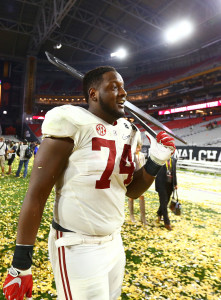
Like Fournette, Cam Robinson will play a large role during his rookie season, as the Alabama product is now the Jaguars’ starting left tackle following the release of Branden Albert. Jacksonville paid 109 cents on the dollar to swap Round 2 picks with Seattle, moving up to No. 34 in order to draft Robinson. Pro Football Focus compared Robinson to former Panthers tackle Michael Oher, noting Robinson’s propensity to vacillate between excellent play and sub-optimal production. In 2016, Robinson ranked 10th among all collegiate tackles with a 97.8 pass-blocking efficiency, but he also committed 23 penalties over the past two seasons.
The rest of the Jaguars’ 2017 draft picks look like backups in Year 1. Defensive lineman Dawuane Smoot could see rotational snaps during his rookie campaign, but is buried on depth chart that contains a multitude of high-end talent. Blair Brown, too, has veterans in front of him, as Myles Jack, Paul Posluszny, and Telvin Smith form one of the league’s more athletic linebacking trios. Fourth-round receiver Dede Westbrook has the best chance to earn an early-season role, as he projects as Jacksonville’s third wideout while Marqise Lee is sidelined.
Extensions and restructures:
Other:
It’s difficult to label David Caldwell‘s tenure as Jaguars general manager anything other than a failure. Clearly, Caldwell didn’t join a Jacksonville club loaded with talent, as the Jags posted a 2-14 record the year before Caldwell was hired. But Caldwell, formerly Atlanta’s director of player personnel, hasn’t done anything to turn around Jacksonville’s fortunes, as the club has produced double-digit-loss seasons in each of the past four years. Caldwell has invested in hefty free agent deals that have gone nowhere, wasted top-five draft choices on selection such as Luke Joeckel and Blake Bortles, and fired his hand-picked head coach, Gus Bradley.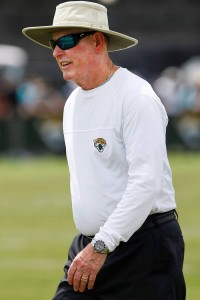
Caldwell earned a contract extension this offseason, but that was mostly in order to line up his deal with that of new executive vice president Tom Coughlin, who was hired as Caldwell’s superior. Everything the Jaguars did this offseason, from the addition of Coughlin, to the decision to retain Doug Marrone as head coach and Nathaniel Hackett as offensive coordinator, points to Jacksonville blowing up its team after 2017. If the Jaguars struggle next season, it won’t be surprising if Caldwell and Marrone are both ousted, leaving Coughlin as the ultimate decision-maker in Jacksonville.
The Jaguars’ recent handling of Bortles also points to a changing of the guard, as the club has now opened up its quarterback battle to a competition between Bortles and Chad Henne. Jacksonville has financial incentive to limit Bortles’ playing time next season, as a catastrophic injury would lead his $19.5MM 2018 option to become fully guaranteed. As such, the Jaguars could place Bortles on the bench for the duration of the year, or could even choose to waive him before the season begins. That’s probably an extreme option, but Jacksonville’s decision to allow Henne to vie for the starting quarterback job is a sign Coughlin is now calling the shots.
Top 10 cap charges for 2017:
- Malik Jackson, DL: $15,500,000
- Calais Campbell, DL: $10,500,000
- Branden Albert, T: $8,900,000
- Barry Church, S: $8,000,000
- Allen Hurns, WR: $7,000,000
- Blake Bortles, QB: $6,571,983
- Jermey Parnell, T: $6,500,000
- Dante Fowler Jr.: $6,406,429
- Tashaun Gipson, S: $6,300,000
- Paul Posluszny, LB: $6,166,668
2017 will undoubtedly be a turning point year for the Jaguars. Typically a preseason sleeper pick, Jacksonville could theoretically take a step forward next season and claim a division title in a weak AFC South. On the other hand, another disappointing campaign will likely lead to the complete overhaul of the roster, coaching staff, and front office. At present, the latter appears more likely, but the Jaguars could certainly shock the NFL world.
Information from Over the Cap and Roster Resource was used in the creation of this post. Photos courtesy of USA Today Sports Images.
By Sam Robinson |
at August 21, 2017 1:14 pm
After qualifying for their first AFC championship game in six seasons, the Steelers are once again positioned as one of the NFL’s best teams. They are firmly in the conversation as being the top AFC challenger to the Patriots and have as good of a case as any team in that group to possess the best shot at dethroning them.
But while the Patriots made several key additions this offseason, the Steelers continued their cautious approach to outside augmentation. The team fans will see this season is largely the same as what Pittsburgh supporters observed in 2016. While that’s not necessarily a bad thing given the success 2016 brought, the Patriots having appeared to improve stands to make the Steelers’ task at reaching their first Super Bowl in seven years more difficult.
Pittsburgh, though, did have several notable moments during the offseason — one headlined by seminal contract outcomes for their top skill-position talents.
Notable signings:
- Le’Veon Bell, RB: One year, $12.12MM. Fully guaranteed. Assigned franchise tag.
- Tyson Alualu, DT: Two years, $6MM. $1.75MM guaranteed.
- Landry Jones, QB: Two years, $4.4MM. $600K guaranteed.
- James Harrison, LB: Two years, $3.5MM. $500K guaranteed.
- Coty Sensabaugh, CB: Two years, $2.6MM. $425K guaranteed.
- David Johnson, TE: Two years, $2.05MM. $235K guaranteed.
- Steven Johnson, LB: One year, minimum salary benefit. $80K guaranteed.
- Justin Hunter, WR: One year, minimum salary benefit. $30K guaranteed.
- Ross Cockrell, CB: One year, $1.797MM. Signed original round RFA tender.
- Chris Hubbard, T: One year, $1.797MM. Signed original round RFA tender.
- Knile Davis, RB: One year, minimum salary benefit.
- Daimion Stafford, S: One year, minimum salary benefit.
- Terrell Watson, RB: One year, $465K.
- JaCorey Shepherd, CB: Contract terms unknown.
 Bell and the Steelers couldn’t come to terms on an agreement, and the star running back remains a holdout. While he’s expected back before the season, this is not an ideal situation. The Steelers reportedly offered the All-Pro talent a competitive deal worth $60MM over five years. Ian Rapoport of NFL.com reported the proposal included $30MM in Years 1-2 and $42MM by Year 3. As a result of the impasse going past July 17, and one that possibly featured Bell reneging on an agreed-upon contract, the sides can’t discuss a long-term deal until after this season.
Bell and the Steelers couldn’t come to terms on an agreement, and the star running back remains a holdout. While he’s expected back before the season, this is not an ideal situation. The Steelers reportedly offered the All-Pro talent a competitive deal worth $60MM over five years. Ian Rapoport of NFL.com reported the proposal included $30MM in Years 1-2 and $42MM by Year 3. As a result of the impasse going past July 17, and one that possibly featured Bell reneging on an agreed-upon contract, the sides can’t discuss a long-term deal until after this season.
The 25-year-old running back reportedly wanted a deal that also reflected his value to the Steelers as a receiver. While it’s true Bell (227 career catches) is essentially Pittsburgh’s No. 2 wideout, that’s become part of the job description for modern-day backs. It’s not as if this skill is overlooked by front offices, with backs who cannot threaten defenses aerially having tougher times getting work. Bell is one of the best there is at this discipline, but turning down a deal that would have placed him on his own financial tier is a risk, especially given his history with injuries and suspensions.
The NFL’s suspended Bell twice for substance abuse, and he’s now undergone knee and groin surgeries over the past two years. His window to sign a mammoth pact like the one reportedly offered is decreasing, especially considering how the Steelers use him. Bell averaged 28 touches per game during the 12 games be played in 2016. That workload will be tough to sustain.
However, the Steelers were willing to pay Bell $14MM on average over the first three years of this deal. His tag amount would be $14.5MM in 2018, and the Steelers — without a replacement lined up — may be amendable to that figure. If so, Bell taking the Kirk Cousins approach would pocket him nearly $30MM in two years. No other running back can match that kind of earning power. But another injury puts these hopes in jeopardy, so Bell not agreeing to long-term security now could be a pivotal moment in his career.
 Other than this, free agency went pretty much as it usually does for Pittsburgh. The build-from-within franchise secured a host of role players’ returns with low-level deals and brought back Harrison again.
Other than this, free agency went pretty much as it usually does for Pittsburgh. The build-from-within franchise secured a host of role players’ returns with low-level deals and brought back Harrison again.
Now 39, Harrison remains the oldest defender in the league. He was a revelation for the AFC North champs last season, ranking as Pro Football Focus’ No. 10 edge defender — ahead of prime talents like Jason Pierre-Paul, Ryan Kerrigan and Bruce Irvin. Pittsburgh also used Harrison on 758 snaps. The workout warrior may be near the end of the line, but the Steelers still figure to coax some final months (or years?) of quality football from the 2008 defensive player of the year. Linebackers coach Joey Porter did say he plans to use the veteran as a “relief pitcher” behind the younger talents this season, though.
Jones will be back to serve as Ben Roethlisberger‘s backup for a third straight season. While the Steelers’ capabilities diminish considerably when Big Ben is out, as he generally is at some point during a season, Jones has been in Todd Haley‘s system for five years now. Jones’ completion rate jumped three percentage points, to 61 percent, last season. He fared better than he did in the past, but the Steelers drafted another quarterback to put Jones on notice. However, for 2017, Jones is probably still the franchise’s QB2.
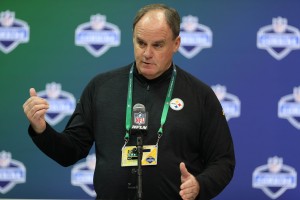 When compared to the Patriots’ offseason additions — Brandin Cooks, Stephon Gilmore, Dwayne Allen and Co. — or the Raiders’ (Marshawn Lynch, Jared Cook, Cordarrelle Patterson), the Steelers’ approach places a premium on draft work. And it’s arguable this lack of action to plug holes, especially on defense, is doing Roethlisberger a disservice. With the 35-year-old passer now on a year-to-year arrangement, Steelers management isn’t exactly maximizing the championship window the quarterback’s given the team the way other AFC frontrunners have in recent years.
When compared to the Patriots’ offseason additions — Brandin Cooks, Stephon Gilmore, Dwayne Allen and Co. — or the Raiders’ (Marshawn Lynch, Jared Cook, Cordarrelle Patterson), the Steelers’ approach places a premium on draft work. And it’s arguable this lack of action to plug holes, especially on defense, is doing Roethlisberger a disservice. With the 35-year-old passer now on a year-to-year arrangement, Steelers management isn’t exactly maximizing the championship window the quarterback’s given the team the way other AFC frontrunners have in recent years.
That said, the Steelers’ methods continue to produce winning teams. It’s just debatable if this offseason caution has restricted them from matching up with conference powers in January during this decade.
Read more
Notable losses:
- Justin Gilbert, CB: Waived
- Ladarius Green, TE: Released
- Ryan Harris, T: Retired
- Jarvis Jones, LB
- Ricardo Mathews, DL
- Zach Mettenberger, QB: Waived
- Shamarko Thomas, S
- Lawrence Timmons, LB
- Greg Warren, LS: Released
- Cody Wallace, OL
- Markus Wheaton, WR
- DeAngelo Williams, RB
 A franchise flush with linebacker tradition saw Timmons become its most identifiable second-level defender this decade. The former first-round pick started for eight straight seasons but did not receive a third Steelers contract, venturing to Miami early in free agency. Pittsburgh already has 2014 first-round pick Ryan Shazier inside, and Vince Williams — signed through 2018 at $2.5MM per year — is much more affordable. The 2013 sixth-rounder figures to move into the starting lineup. Former Broncos two-down player Steven Johnson provides depth.
A franchise flush with linebacker tradition saw Timmons become its most identifiable second-level defender this decade. The former first-round pick started for eight straight seasons but did not receive a third Steelers contract, venturing to Miami early in free agency. Pittsburgh already has 2014 first-round pick Ryan Shazier inside, and Vince Williams — signed through 2018 at $2.5MM per year — is much more affordable. The 2013 sixth-rounder figures to move into the starting lineup. Former Broncos two-down player Steven Johnson provides depth.
Pittsburgh deviated from its usual offseason shtick last March by signing Green for four years and $20MM, but significant injury issues essentially deprived Green from making an impact in western Pennsylvania. The Steelers cut him and will carry $3.562MM in dead money on their 2017 cap. No comparable outside acquisitions came in 2017, and the Steelers are back to using in-house tight ends. Six-foot-7 Jesse James is only entering his age-23 season and looks set to start, as he did for most of last season.
 The modern-era Steelers have continued to churn out viable wide receivers and have been keen to watch most of them sign their second contracts elsewhere. From Plaxico Burress to Santonio Holmes to Mike Wallace to Emmanuel Sanders, the team has shown an incredible acumen for identifying wideouts. The Steelers’ second era of Super Bowl success involved treating every receiver except for Hines Ward and Antionio Brown as superfluous cogs.
The modern-era Steelers have continued to churn out viable wide receivers and have been keen to watch most of them sign their second contracts elsewhere. From Plaxico Burress to Santonio Holmes to Mike Wallace to Emmanuel Sanders, the team has shown an incredible acumen for identifying wideouts. The Steelers’ second era of Super Bowl success involved treating every receiver except for Hines Ward and Antionio Brown as superfluous cogs.
Lately, Day 2 of the draft’s served as the Steelers’ preference for securing talent to replace departed players. That tradition continued this offseason, just as it did when Sanders departed and second-rounder Martavis Bryant arrived shortly after. JuJu Smith-Schuster came via second-round pick to replace Wheaton, who delivered an up-and-down career.
The ex-Oregon State sprinter became a serviceable complement to Brown, averaging 17 yards per catch en route to 749 yards and five touchdown receptions in 2015. Sent to IR midway through the season, Wheaton was one of many Steelers skill-position talents absent by the time they faced the Patriots in the championship game. With Bryant, Sammie Coates, Eli Rogers and Smith-Schuster in tow, Pittsburgh has a good chance of replacing Wheaton as it has his supporting-cast predecessors.
 Whereas receiver’s been a Day 2 priority in drafts, Pittburgh continues to pour resources into first-round pass rushers. T.J. Watt will replace Jarvis Jones, who did not make the kind of impact the team envisioned when it used a 2013 Round 1 selection on the Georgia dynamo. Even after Jones and Timmons’ exits, the Steelers still have three first-round ‘backers. Arthur Moats is a solid reserve as well.
Whereas receiver’s been a Day 2 priority in drafts, Pittburgh continues to pour resources into first-round pass rushers. T.J. Watt will replace Jarvis Jones, who did not make the kind of impact the team envisioned when it used a 2013 Round 1 selection on the Georgia dynamo. Even after Jones and Timmons’ exits, the Steelers still have three first-round ‘backers. Arthur Moats is a solid reserve as well.
Williams remains available, and he did not place his most recent employer among the teams with which he wouldn’t sign. Now equipped with third-rounder James Conner to supplement Fitzgerald Toussaint, the Steelers would seemingly be covered without the 34-year-old running back if Bell returned before the regular season as he’s expected to. If he doesn’t, then a Williams re-up makes sense. Williams functioned impressively for Pittsburgh during the 2015 season, amassing 907 ground yards and 11 rushing touchdowns. His yards-per-carry average dropped from 4.5 to 3.5 from 2015 to ’16, though.
Draft picks:
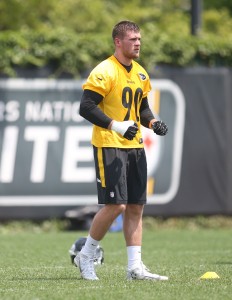 Watt continues the Steelers’ aggressive investment strategy regarding pass-rushing talent, with three of the team’s past five first-round picks going toward outside linebackers. The third of the Watt brothers to ascend to the NFL, T.J. Watt augments Pittsburgh’s situation at outside ‘backer. The Steelers have two first-rounders (Watt, Bud Dupree) and two proven veterans (Harrison, Moats) outside.
Watt continues the Steelers’ aggressive investment strategy regarding pass-rushing talent, with three of the team’s past five first-round picks going toward outside linebackers. The third of the Watt brothers to ascend to the NFL, T.J. Watt augments Pittsburgh’s situation at outside ‘backer. The Steelers have two first-rounders (Watt, Bud Dupree) and two proven veterans (Harrison, Moats) outside.
The Steelers finished 16th in sacks with 38 last season. Watt wasn’t viewed as a can’t-miss pass rusher, although he posted upper-echelon Combine numbers to indicate a possible future as such. And the Wisconsin standout became a much more disruptive force as a junior in increasing his pressures from 12 as a sophomore to 56 in his third college season.
Of course, 2016 was the only season that featured much Watt work, with J.J. Watt‘s younger brother playing 661 snaps last season compared to just 174 in 2015. So, the Steelers are pretty much going off that — and perhaps the otherworldly success J.J. has enjoyed since entering the league.

Smith-Schuster was a three-year fixture in the USC offense. His sophomore season — 1,454 yards, 16.3 per catch, 10 touchdowns — was stronger than his follow-up effort last fall. Although, the Trojans target still caught 10 touchdowns despite seeing his yards-per-catch figure plummet by more than three yards. The way the Steelers are presently constructed, Smith-Schuster won’t be asked to be an instant contributor. But he could be a red zone weapon and will provide depth for a team that was short on it by the end of last season.
Receiving steady reps as the Steelers’ No. 1 back, Conner steps into an interesting situation. At 235 pounds, the ex-Pittsburgh Panther could bring a complementary element to the shiftier Bell. The Steelers use Bell as a throwback bellcow-type ball carrier, but Conner has the body type — and the numbers, with 42 touchdowns during his sophomore and senior seasons combined — to be effective in short-yardage situations.
This was the third straight year the Steelers selected a corner with a Day 1 or Day 2 pick, and Sutton will push thus-far-unavailable Senquez Golson for time as a top backup behind Artie Burns, Ross Cockrell and William Gay. Golson may be on the ropes at this point, per DC Keith Butler. Dobbs profiles as a project player who can learn behind Roethlisberger and Jones.
Extensions and restructures:
 After signing what turned out to be an incredibly team-friendly contract, Brown finally secured his overdue payday. The Steelers held firm on their policy not to address contracts with more than one year remaining on them, and Brown stayed healthy to move into a position to become the league’s highest-paid wideout. He’s now $2MM clear of the field on the wideout salary hierarchy, on a per-year basis, and Brown’s deal will undoubtedly be used when it comes time for Odell Beckham Jr. and Mike Evans to discuss extensions.
After signing what turned out to be an incredibly team-friendly contract, Brown finally secured his overdue payday. The Steelers held firm on their policy not to address contracts with more than one year remaining on them, and Brown stayed healthy to move into a position to become the league’s highest-paid wideout. He’s now $2MM clear of the field on the wideout salary hierarchy, on a per-year basis, and Brown’s deal will undoubtedly be used when it comes time for Odell Beckham Jr. and Mike Evans to discuss extensions.
Entering his age-29 season, Brown is the only active receiver with three first-team All-Pro honors on his resume. Only three modern-era wideouts — Jerry Rice, Terrell Owens and Randy Moss — have earned more than three such distinctions. The former sixth-round pick out of Central Michigan has turned in the most productive four-season stretch any receiver’s ever authored and is on a Hall of Fame course.
Brown being tied to Pittsburgh for five more seasons, with Pittsburgh being unable to comfortably jettison the contract until the 2021 season, could affect Roethlisberger’s retirement decision. Big Ben considered stepping away this offseason but backed out. Now, he has Brown and Bryant tied to the Steelers for at least two more seasons.
 Roethlisberger’s blindside protector did not have as obvious of a case as Brown for a new contract. Villanueva’s late NFL entry placed him as a rare 28-year-old ERFA; two more years remained on his league-minimum deal. While the starting left tackle had outplayed that agreement, the Steelers didn’t have much incentive for enhancing Villaueva’s salary. And these discussions transpired for months.
Roethlisberger’s blindside protector did not have as obvious of a case as Brown for a new contract. Villanueva’s late NFL entry placed him as a rare 28-year-old ERFA; two more years remained on his league-minimum deal. While the starting left tackle had outplayed that agreement, the Steelers didn’t have much incentive for enhancing Villaueva’s salary. And these discussions transpired for months.
But like they did with ERFA-turned-Super Bowl hero Willie Parker a decade before, the Steelers came to an agreement with Villanueva. He could have possibly gotten more per year when he became a UFA, but being that he would have been almost 30 once he hit the market, Villanueva and the Steelers came to a compromise. While $6MM AAV is lower-end starting left tackle money, placing Villanueva 20th — and essentially last among non-rookie-deal blindside blockers — the ex-UDFA accepted the terms to secure a reasonable commitment before his value potentially deteriorates.
Other:
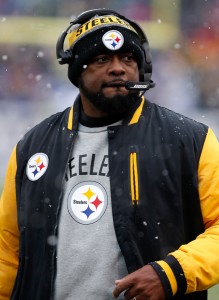 In extending Tomlin through 2020, the Steelers could be set up for an unthinkable procession of leaders. Should Tomlin coach through the 2020 campaign, which would be his 14th as a head coach, the franchise will have gone more than 50 years with just three head coaches. While Chuck Noll did the most to make this a possibility in coaching for 23 seasons (1969-91), Bill Cowher (1992-2006) and Tomlin have played big parts in the continuity associated with this operation.
In extending Tomlin through 2020, the Steelers could be set up for an unthinkable procession of leaders. Should Tomlin coach through the 2020 campaign, which would be his 14th as a head coach, the franchise will have gone more than 50 years with just three head coaches. While Chuck Noll did the most to make this a possibility in coaching for 23 seasons (1969-91), Bill Cowher (1992-2006) and Tomlin have played big parts in the continuity associated with this operation.
Obviously leading the league with six Super Bowl titles, the Steelers are one of just two teams — joining the Broncos — to have made a conference title game in the 1970s, ’80s, ’90s, ’00s and ’10s. While Tomlin’s had the benefit of Roethlisberger to help install the Steelers as perpetual contenders, Pittsburgh fielded elite defenses during its championship runs in the defensive-minded coach’s early years. And the steady success will have the 45-year-old HC set to become one of the highest-paid sideline bosses in the game.
 When on the field, Shazier has shown himself to be one of the most athletic pure linebackers in the game. While he’s missed 14 games in his three-year career, Shazier enters 2017 as one of Pittsburgh’s most important players. In addition to finishing with exactly 87 tackles and 3.5 sacks for a second straight season, Shazier intercepted three passes and deflected nine more. The versatile ‘backer isn’t a fan of the fifth-year option, but with none of the other 2014 first-rounders having signed extensions yet, his franchise isn’t planning to buck the trend first.
When on the field, Shazier has shown himself to be one of the most athletic pure linebackers in the game. While he’s missed 14 games in his three-year career, Shazier enters 2017 as one of Pittsburgh’s most important players. In addition to finishing with exactly 87 tackles and 3.5 sacks for a second straight season, Shazier intercepted three passes and deflected nine more. The versatile ‘backer isn’t a fan of the fifth-year option, but with none of the other 2014 first-rounders having signed extensions yet, his franchise isn’t planning to buck the trend first.
The Steelers did not replace Bryant effectively last season, and it lowered their offensive ceiling. Coates has yet to show much consistency, and Wheaton’s injury further limited Roethlisberger’s weaponry. Bryant has scored 14 touchdowns in 21 games and is one of the NFL’s premier deep threats. The Steelers still managed to rank fifth in passing last season but finished with 400 fewer yards than 2015 despite Roethlisberger playing in two more games. Roethlisberger’s 328.2 passing yards per game from 2015 are by far a career high, and his 4,952 yards in 2014 easily represent his best as an NFLer.
Bryant undoubtedly adds a dimension to this offense but will obviously have to prove he’s moved past the off-field trouble that’s defined his career.
Top 10 cap charges for 2017:
- Ben Roethlisberger, QB: $18,200,000
- Antonio Brown, WR: $13,618,334
- Le’Veon Bell, RB: $12,120,000
- Maurkice Pouncey, C: $11,051,000
- David DeCastro, G: $11,050,000
- Cameron Heyward, DE: $10,400,000
- Mike Mitchell, S: $8,135,416
- Marcus Gilbert, T: $7,308,500
- Ramon Foster, G: $3,591,666
- Ladarius Green, TE: $3,562,500 (dead money)
The Steelers return many players responsible for securing three straight playoff berths, but for having a future Hall of Fame quarterback, an argument can be made the team has underachieved in recent seasons. This one represents another chance to capitalize on having Roethlisberger under center.
With upgrades coming at wideout and pass rusher, the Steelers should be better than they were in 2016. Roethlisberger’s health is obviously essential. But with top AFC North rivals Cincinnati and Baltimore potentially not being playoff-caliber teams, Pittsburgh has a better chance to challenge for its first playoff bye since 2010.
The case for the Steelers having improved exists, but one based around the franchise not doing enough this offseason to present the best possible challenge to the Patriots does as well. As such, it will be on the Steelers’ holdovers to make this a keystone season.
Information from Over the Cap and Roster Resource was used in the creation of this post. Photos courtesy of USA Today Sports Images.
 If 2020’s Kendall Hinton-quarterbacked contest is counted, the Broncos match Washington with an NFL-most 11 starting QBs since 2016. An inability to generate above-average QB play through trades (Joe Flacco, Teddy Bridgewater), free agency (Case Keenum) or the draft (Lock, Paxton Lynch) dragged Denver from an AFC power to a team with a lower-middle-class ceiling. This descent prompted second-year GM George Paton to fork over one of the biggest trade hauls in NFL history — though a package not quite as valuable as some expected — to make a clear upgrade.
If 2020’s Kendall Hinton-quarterbacked contest is counted, the Broncos match Washington with an NFL-most 11 starting QBs since 2016. An inability to generate above-average QB play through trades (Joe Flacco, Teddy Bridgewater), free agency (Case Keenum) or the draft (Lock, Paxton Lynch) dragged Denver from an AFC power to a team with a lower-middle-class ceiling. This descent prompted second-year GM George Paton to fork over one of the biggest trade hauls in NFL history — though a package not quite as valuable as some expected — to make a clear upgrade. Signing the former suspension mainstay is a gamble for the Broncos; the 2015 second-rounder has been banned four times for substance-abuse policy violations. Between the 2016, ’17 and ’19 seasons, Gregory combined for two games. This could give him a “young 29”-type presence, due to limited wear and tear, but Gregory also missed time with a calf injury and has been limited this offseason due to shoulder surgery. Still, Gregory’s early-season surge in 2021 (five sacks, 11 QB hits and two forced fumbles in a four-game span), before his calf issue paused that stretch, created a live market. How Gregory lives up to his first notable NFL contract will determine the Broncos’ post-Miller pass-rushing outlook.
Signing the former suspension mainstay is a gamble for the Broncos; the 2015 second-rounder has been banned four times for substance-abuse policy violations. Between the 2016, ’17 and ’19 seasons, Gregory combined for two games. This could give him a “young 29”-type presence, due to limited wear and tear, but Gregory also missed time with a calf injury and has been limited this offseason due to shoulder surgery. Still, Gregory’s early-season surge in 2021 (five sacks, 11 QB hits and two forced fumbles in a four-game span), before his calf issue paused that stretch, created a live market. How Gregory lives up to his first notable NFL contract will determine the Broncos’ post-Miller pass-rushing outlook. Gilmore, a 2012 first-round pick, set a career-high with five interceptions last season, and he also compiled 48 tackles and 12 passes defended. ProFootballFocus wasn’t particularly fond of his performance in Buffalo, ranking him 61st among 110 eligible cornerbacks. Butler, meanwhile, ranked seventh, and despite Gilmore’s shortcomings, the two cornerbacks should still form a formidable duo.
Gilmore, a 2012 first-round pick, set a career-high with five interceptions last season, and he also compiled 48 tackles and 12 passes defended. ProFootballFocus wasn’t particularly fond of his performance in Buffalo, ranking him 61st among 110 eligible cornerbacks. Butler, meanwhile, ranked seventh, and despite Gilmore’s shortcomings, the two cornerbacks should still form a formidable duo. On the offensive side of the ball, the Patriots made several signings as they looked to replace the departed LeGarrette Blount. New England’s running game is usually unpredictable, but Mike Gillislee figures to play a prominent role in 2017. The former fifth-round pick made a name for himself last year with the Bills, compiling career-highs in attempts (101), yards (577), and rushing touchdowns (eight). Of course, the Patriots coaches were probably most enticed by his one career fumble, and his career 6.7-yards-per-carry mark is a big reason why he could be the main replacement for Blount. The Patriots also signed former Bengals running back Rex Burkhead, who also had a bit of a breakout year in 2016. Injuries limited the 27-year-old during the preseason, although there’s always a chance that Burkhead can ultimately lead the team in carries. The Patriots have always thrived when using an unpredictable running game, and we’ll presumably see the team utilize the best backs for specific matchups.
On the offensive side of the ball, the Patriots made several signings as they looked to replace the departed LeGarrette Blount. New England’s running game is usually unpredictable, but Mike Gillislee figures to play a prominent role in 2017. The former fifth-round pick made a name for himself last year with the Bills, compiling career-highs in attempts (101), yards (577), and rushing touchdowns (eight). Of course, the Patriots coaches were probably most enticed by his one career fumble, and his career 6.7-yards-per-carry mark is a big reason why he could be the main replacement for Blount. The Patriots also signed former Bengals running back Rex Burkhead, who also had a bit of a breakout year in 2016. Injuries limited the 27-year-old during the preseason, although there’s always a chance that Burkhead can ultimately lead the team in carries. The Patriots have always thrived when using an unpredictable running game, and we’ll presumably see the team utilize the best backs for specific matchups. For now, Glennon will have another chance to show he can be an NFL starter. A recurring subject of trade rumors in recent years, the former Buccaneers third-round pick will throw more passes in Week 1 than he did in the past two seasons combined. But in less than two months, Glennon reverted to lame-duck status. Only instead of having the opportunity to display his qualifications for a starting job over the course of a sizable work sample (18 starts for the Bucs from 2013-14), the 27-year-old passer may not have much job security in his new city.
For now, Glennon will have another chance to show he can be an NFL starter. A recurring subject of trade rumors in recent years, the former Buccaneers third-round pick will throw more passes in Week 1 than he did in the past two seasons combined. But in less than two months, Glennon reverted to lame-duck status. Only instead of having the opportunity to display his qualifications for a starting job over the course of a sizable work sample (18 starts for the Bucs from 2013-14), the 27-year-old passer may not have much job security in his new city. Many Bears UFA deals were not needle-movers, with the franchise striking out on some big-money targets — from A.J. Bouye to Stephon Gilmore to an Alshon Jeffery re-signing — and the franchise instead spent money on several second-tier acquisitions. This took place at both cornerback and wide receiver.
Many Bears UFA deals were not needle-movers, with the franchise striking out on some big-money targets — from A.J. Bouye to Stephon Gilmore to an Alshon Jeffery re-signing — and the franchise instead spent money on several second-tier acquisitions. This took place at both cornerback and wide receiver. With Cameron Meredith out for the year, the situation is just as strange now at wide receiver.
With Cameron Meredith out for the year, the situation is just as strange now at wide receiver. The Bears also have a veteran-laden tight end assembly, with a Zach Miller/Sims combination occupying this spot while Adam Shaheen develops. Sims showed little as a receiver with the Dolphins and is not coming off a season where he displayed much in the run-blocking department — at least, not in the view of PFF — and his contract parallels Glennon’s in being basically a one-year commitment. Virtually no guarantees exist on Sims’ deal in 2018 or ’19, so he’ll have to show more this season than he did during his first four (699 career receiving yards).
The Bears also have a veteran-laden tight end assembly, with a Zach Miller/Sims combination occupying this spot while Adam Shaheen develops. Sims showed little as a receiver with the Dolphins and is not coming off a season where he displayed much in the run-blocking department — at least, not in the view of PFF — and his contract parallels Glennon’s in being basically a one-year commitment. Virtually no guarantees exist on Sims’ deal in 2018 or ’19, so he’ll have to show more this season than he did during his first four (699 career receiving yards).
 The Jets made a low-risk/high-reward signing by adding cornerback Morris Claiborne in March. There’s just one problem here – what good will it do the Jets to have a quality cornerback on a one-year deal when the rest of the team is not equipped to win? Then again, if the Jets wanted to add a second or third year to the deal, it would have cost them a pretty penny. The Claiborne deal came in at just $5MM for this year and that will be a steal if Claiborne can perform like he did in his injury-shorted 2016 campaign. Claiborne was on the field for only seven games, but he finished out as Pro Football Focus’ 12th ranked corner for his work in Dallas. If he plays well, it’s possible that the Jets will re-sign him to a long-term deal, allowing him to be a part of the franchise’s turnaround.
The Jets made a low-risk/high-reward signing by adding cornerback Morris Claiborne in March. There’s just one problem here – what good will it do the Jets to have a quality cornerback on a one-year deal when the rest of the team is not equipped to win? Then again, if the Jets wanted to add a second or third year to the deal, it would have cost them a pretty penny. The Claiborne deal came in at just $5MM for this year and that will be a steal if Claiborne can perform like he did in his injury-shorted 2016 campaign. Claiborne was on the field for only seven games, but he finished out as Pro Football Focus’ 12th ranked corner for his work in Dallas. If he plays well, it’s possible that the Jets will re-sign him to a long-term deal, allowing him to be a part of the franchise’s turnaround.









 Bell and the Steelers couldn’t come to terms on an agreement, and the star running back remains a holdout. While he’s expected back before the season, this is not an ideal situation. The Steelers reportedly offered the All-Pro talent a competitive deal worth $60MM over five years. Ian Rapoport of NFL.com reported the proposal included $30MM in Years 1-2 and $42MM by Year 3. As a result of the impasse going past July 17, and one that possibly featured Bell reneging on an agreed-upon contract, the sides can’t discuss a long-term deal until after this season.
Bell and the Steelers couldn’t come to terms on an agreement, and the star running back remains a holdout. While he’s expected back before the season, this is not an ideal situation. The Steelers reportedly offered the All-Pro talent a competitive deal worth $60MM over five years. Ian Rapoport of NFL.com reported the proposal included $30MM in Years 1-2 and $42MM by Year 3. As a result of the impasse going past July 17, and one that possibly featured Bell reneging on an agreed-upon contract, the sides can’t discuss a long-term deal until after this season. Other than this, free agency went pretty much as it usually does for Pittsburgh. The build-from-within franchise secured a host of role players’ returns with low-level deals and brought back Harrison again.
Other than this, free agency went pretty much as it usually does for Pittsburgh. The build-from-within franchise secured a host of role players’ returns with low-level deals and brought back Harrison again. When compared to the Patriots’ offseason additions — Brandin Cooks, Stephon Gilmore, Dwayne Allen and Co. — or the Raiders’ (Marshawn Lynch, Jared Cook, Cordarrelle Patterson), the Steelers’ approach places a premium on draft work. And it’s arguable this lack of action to plug holes, especially on defense, is doing Roethlisberger a disservice. With the 35-year-old passer now on a year-to-year arrangement, Steelers management isn’t exactly maximizing the championship window the quarterback’s given the team the way other AFC frontrunners have in recent years.
When compared to the Patriots’ offseason additions — Brandin Cooks, Stephon Gilmore, Dwayne Allen and Co. — or the Raiders’ (Marshawn Lynch, Jared Cook, Cordarrelle Patterson), the Steelers’ approach places a premium on draft work. And it’s arguable this lack of action to plug holes, especially on defense, is doing Roethlisberger a disservice. With the 35-year-old passer now on a year-to-year arrangement, Steelers management isn’t exactly maximizing the championship window the quarterback’s given the team the way other AFC frontrunners have in recent years.










































